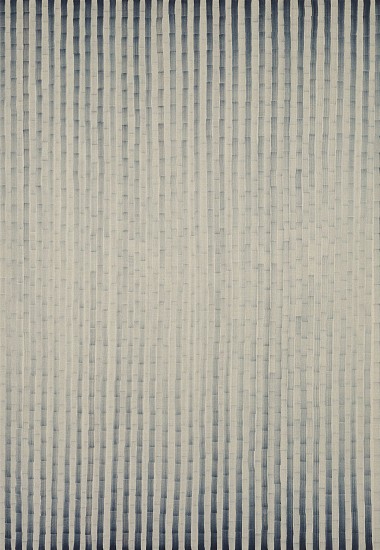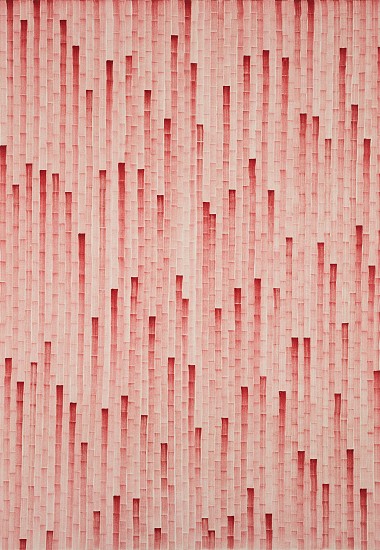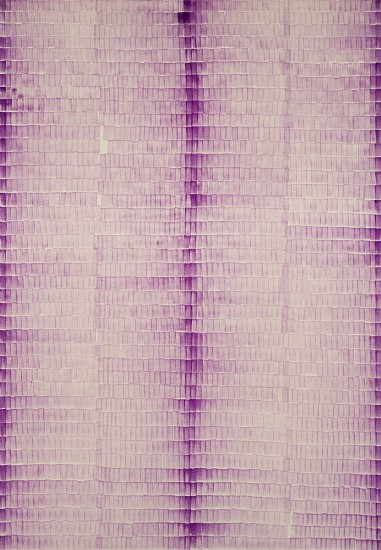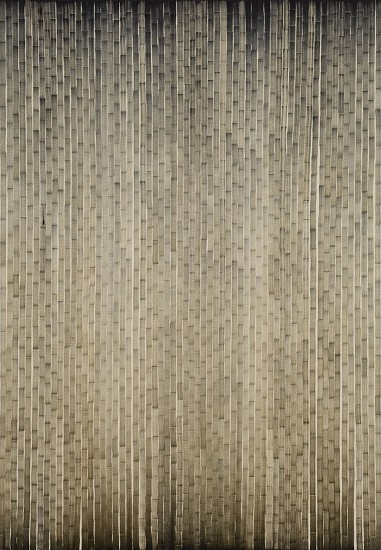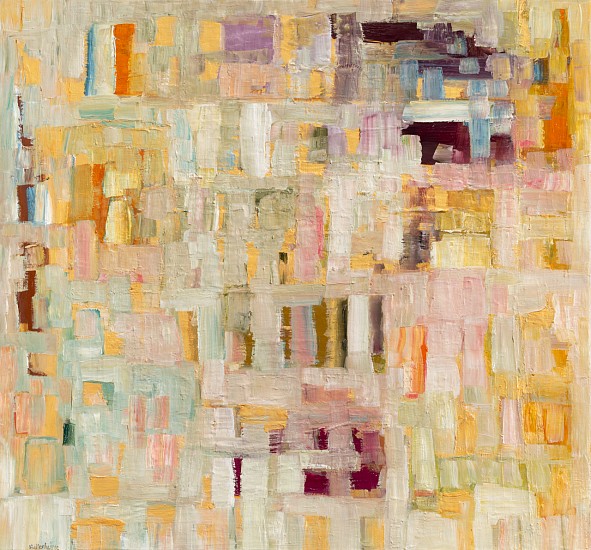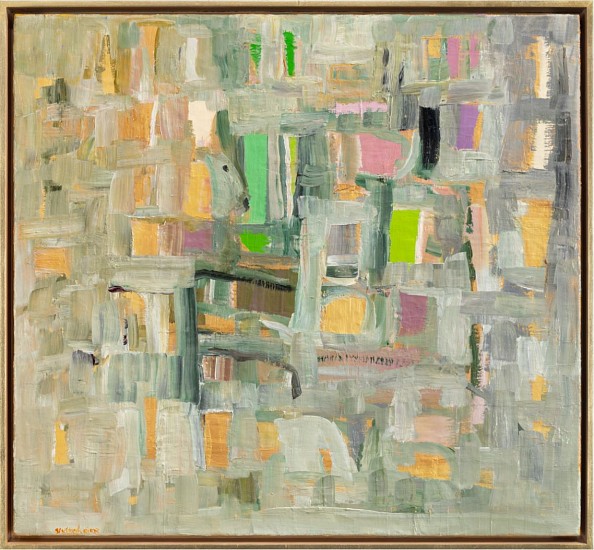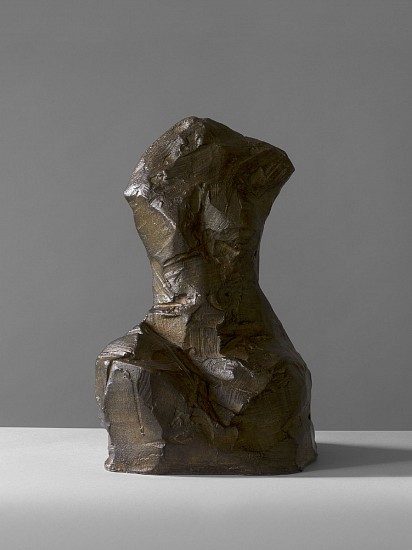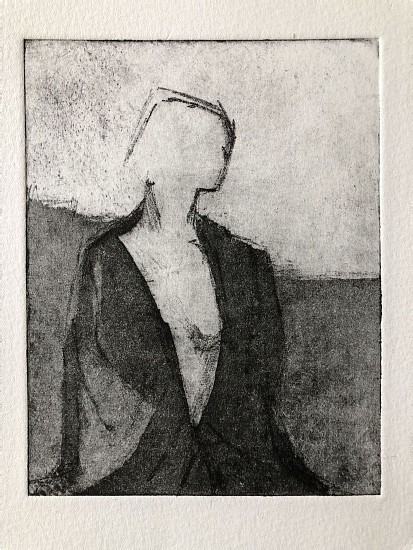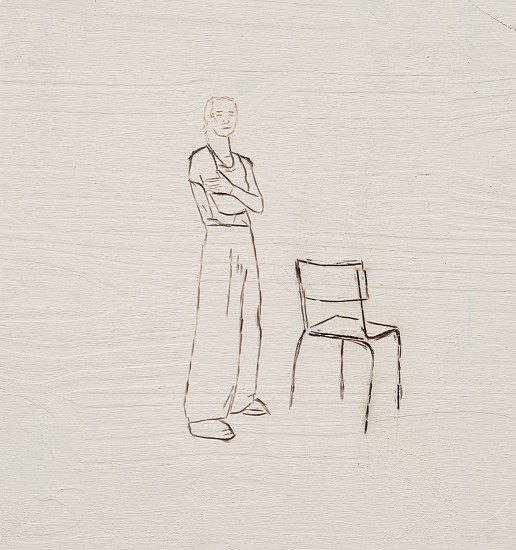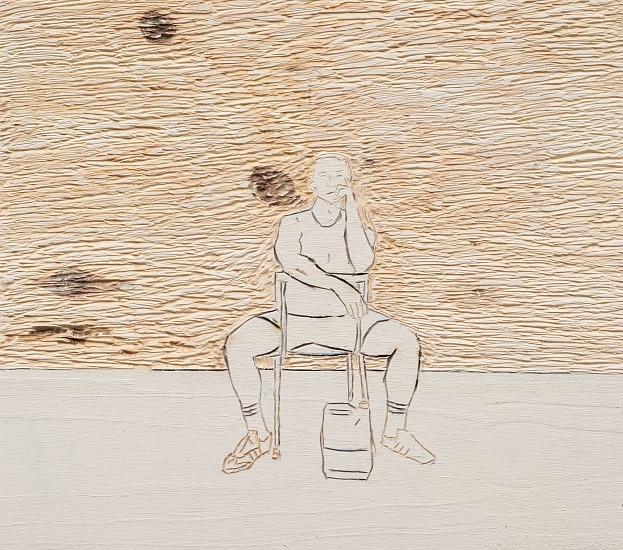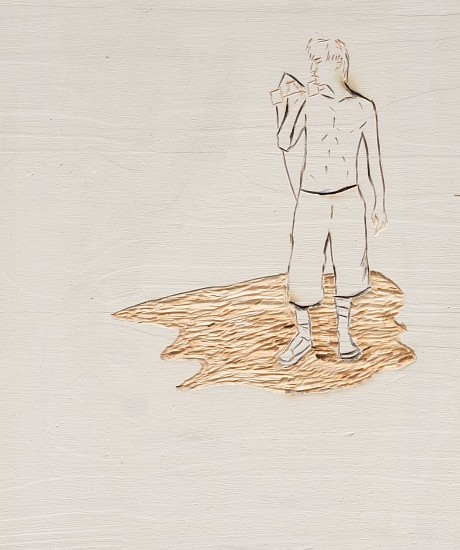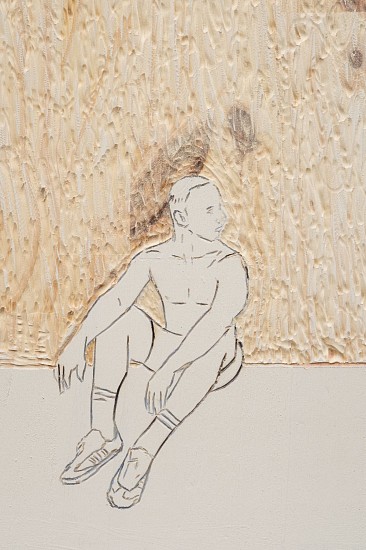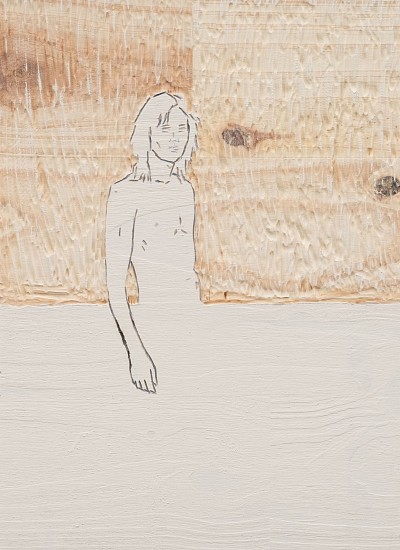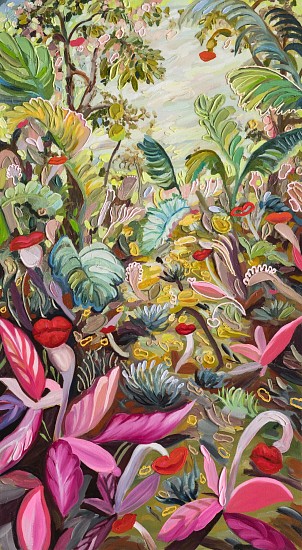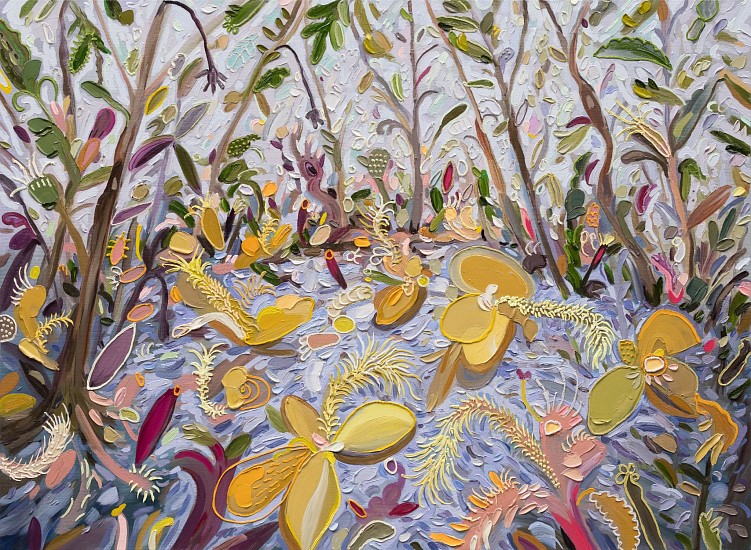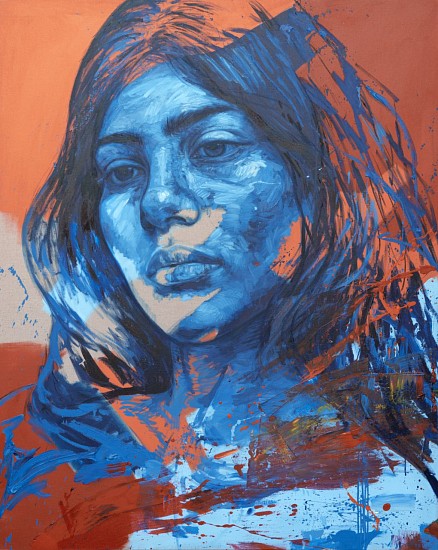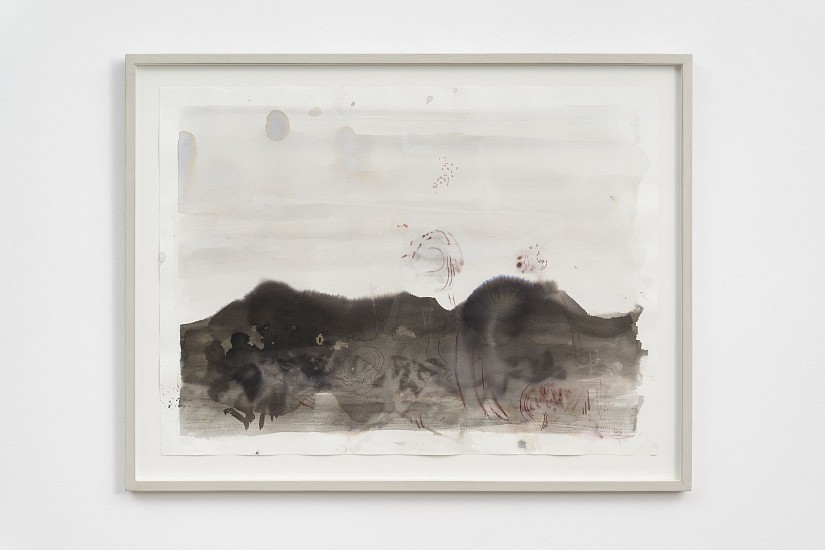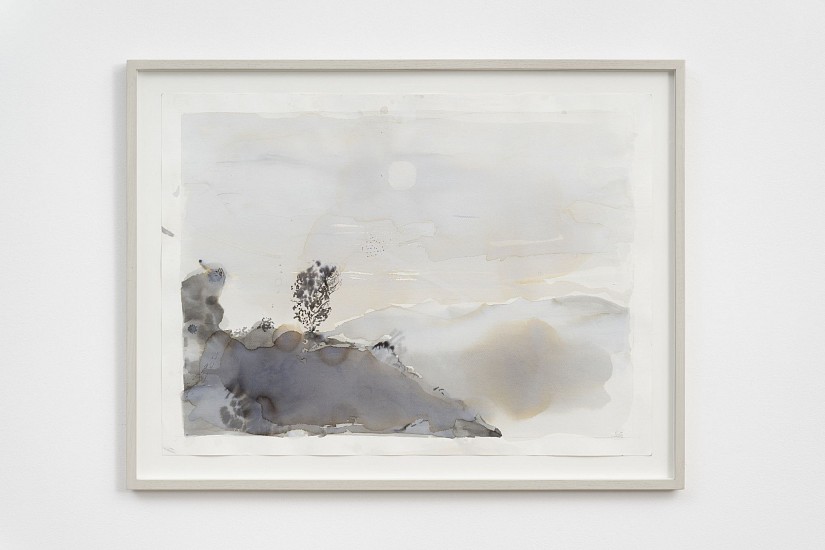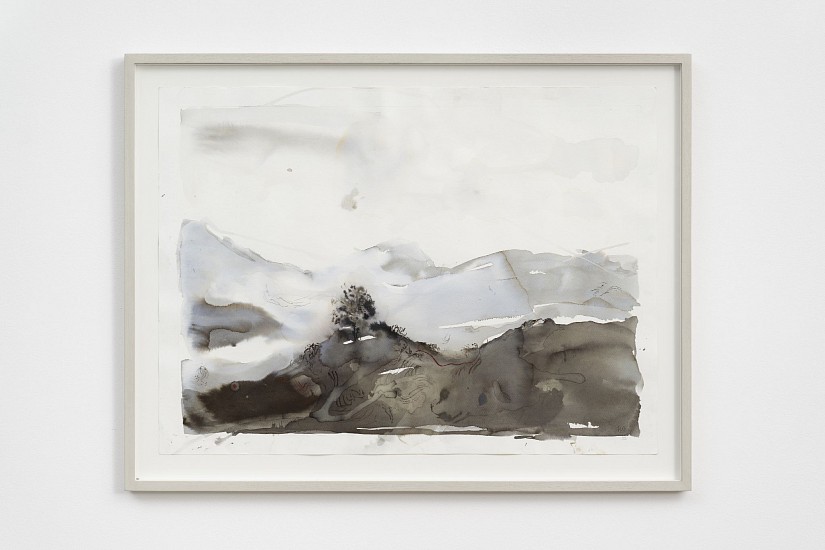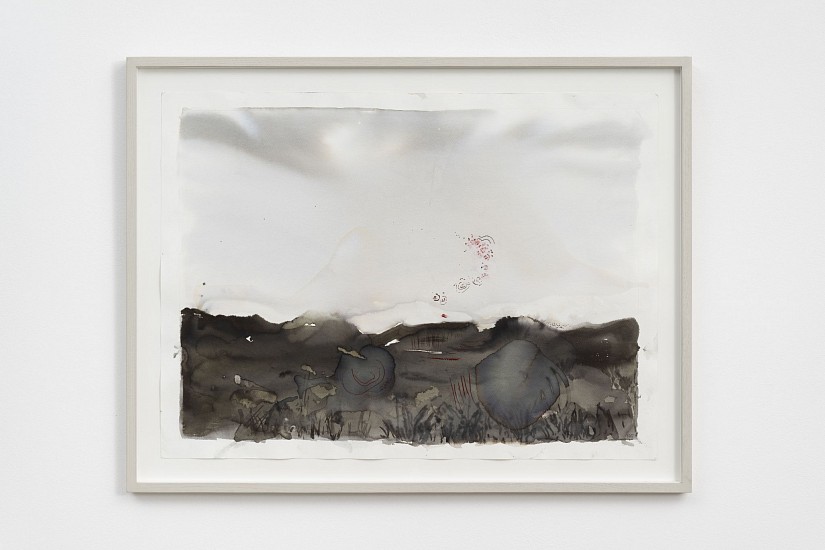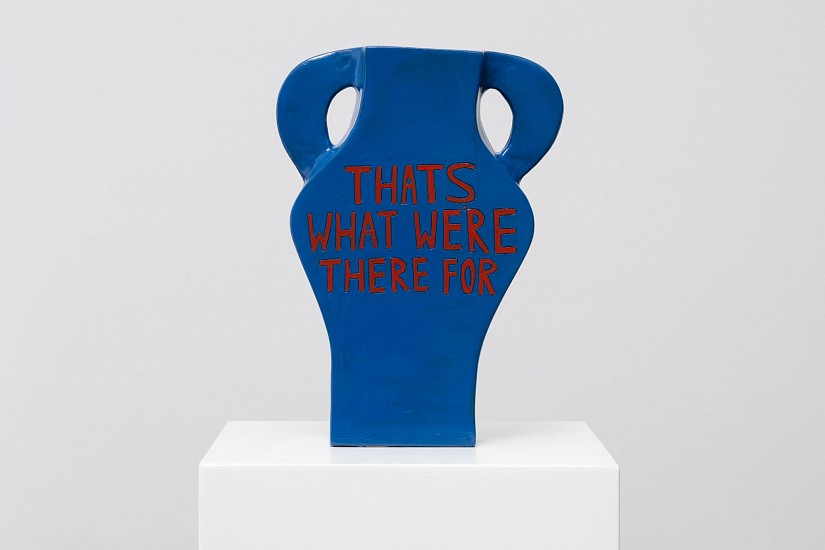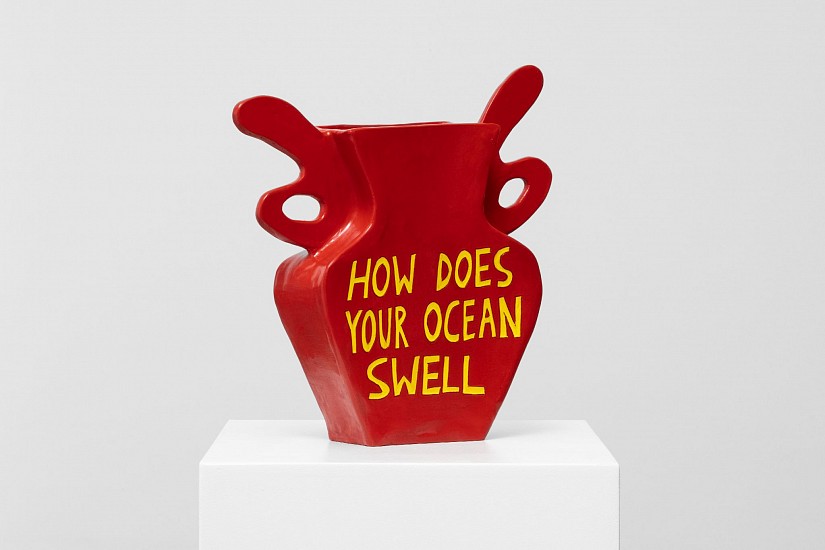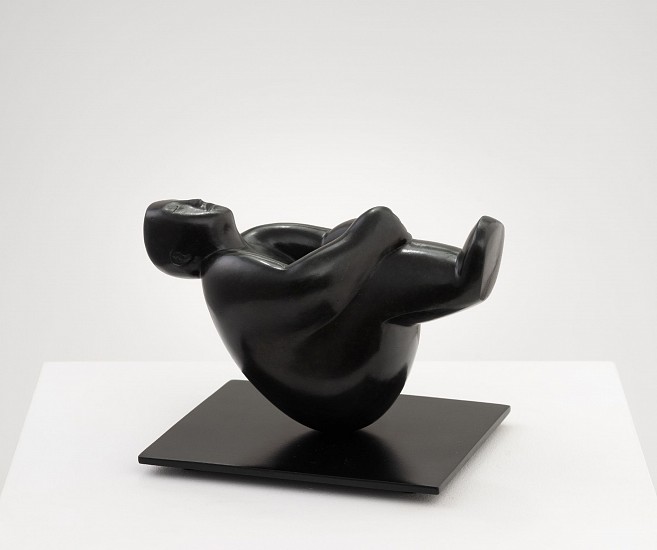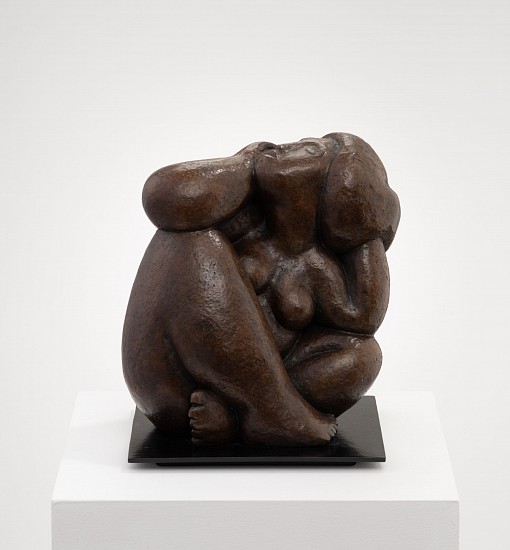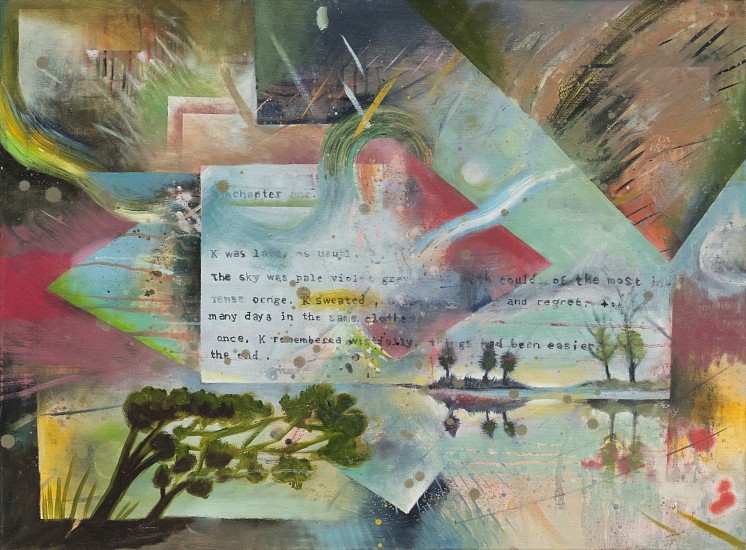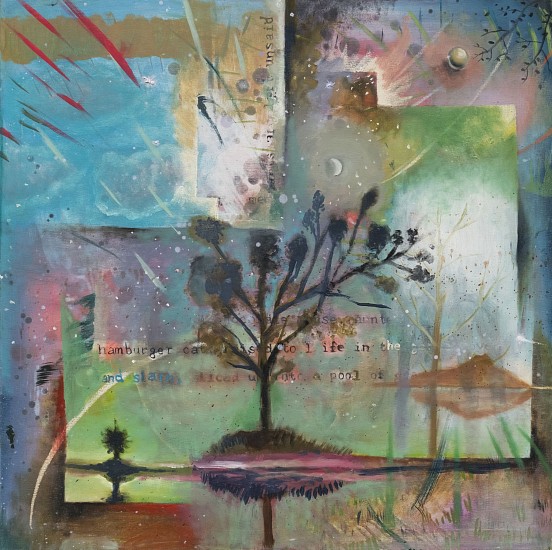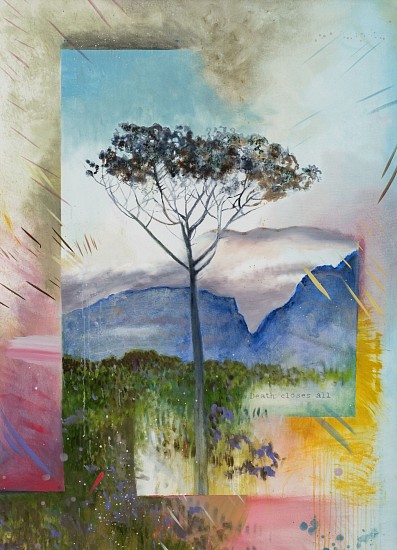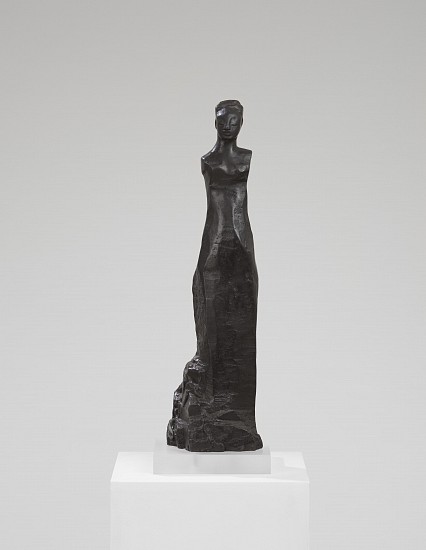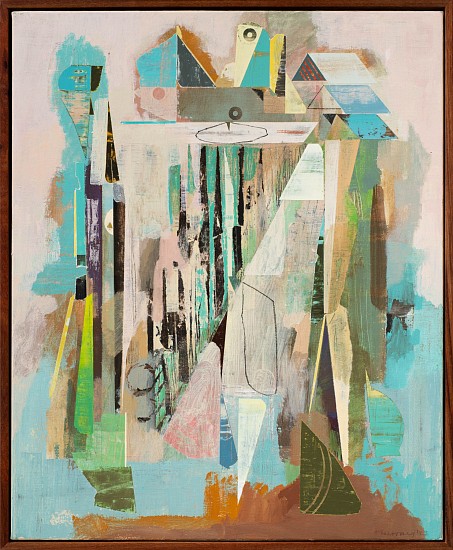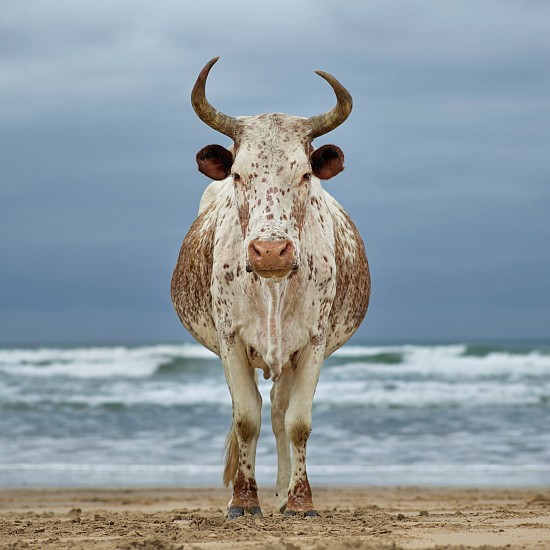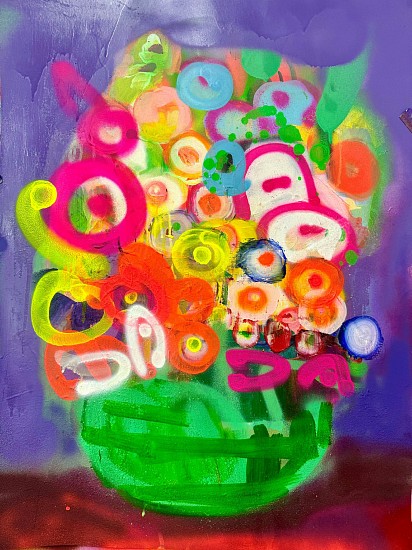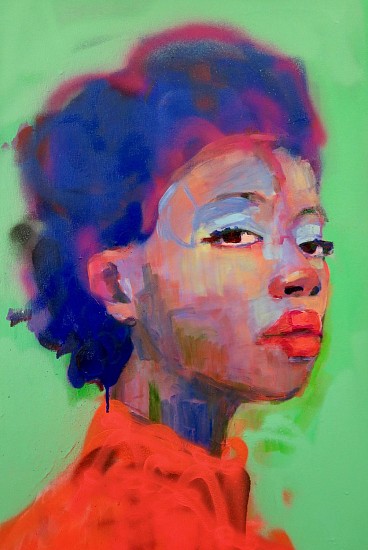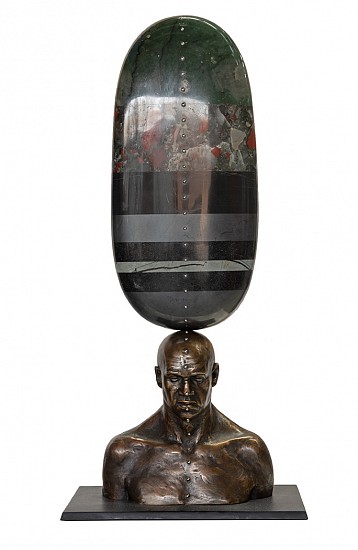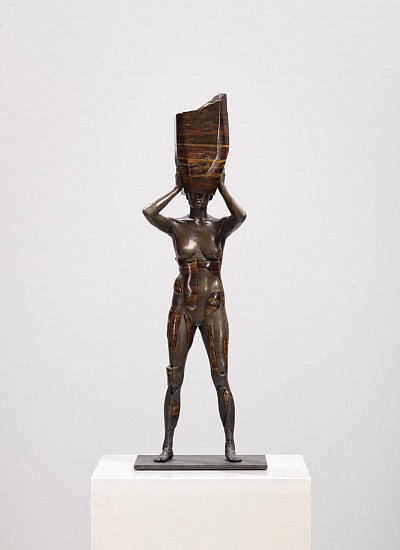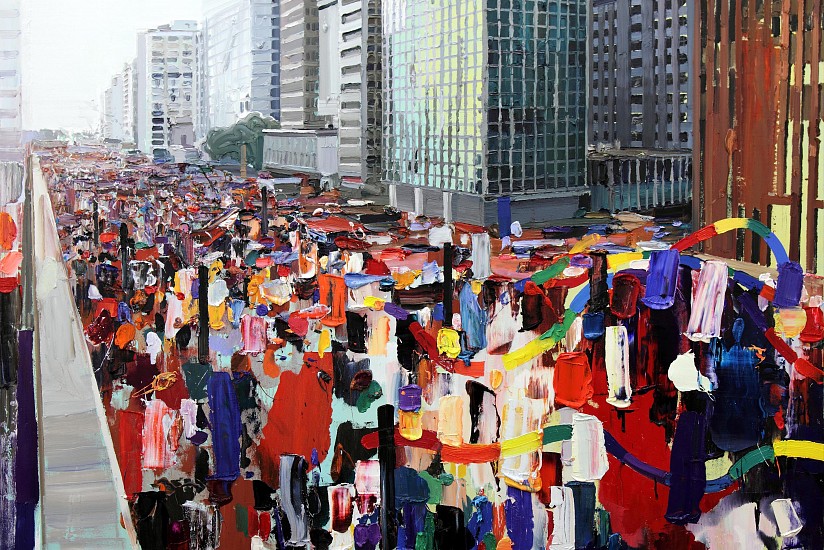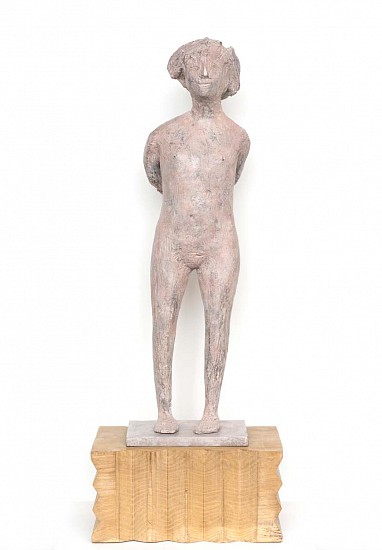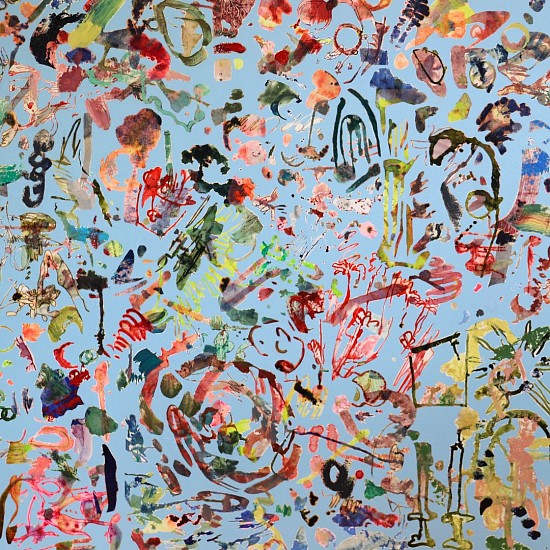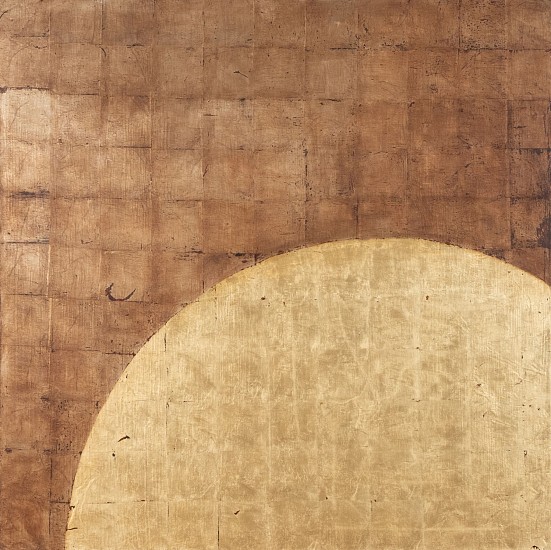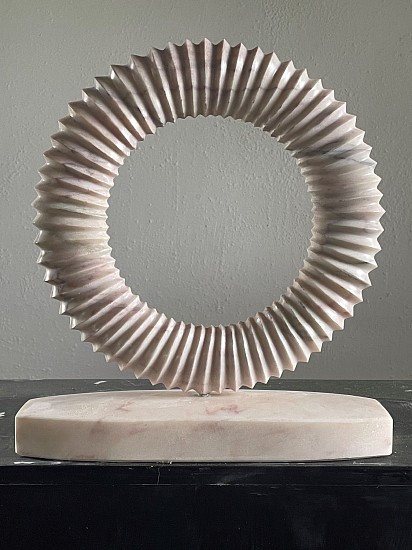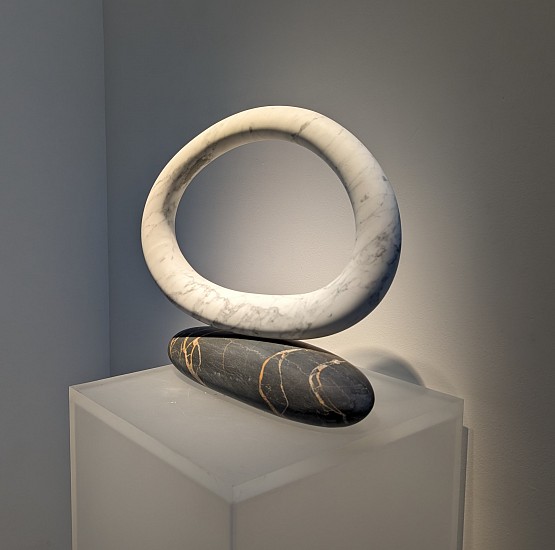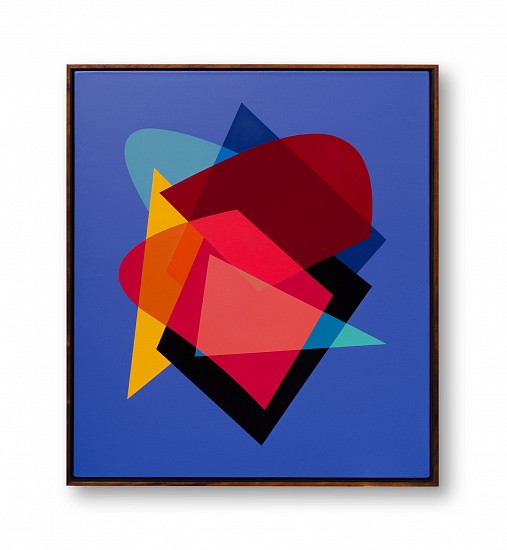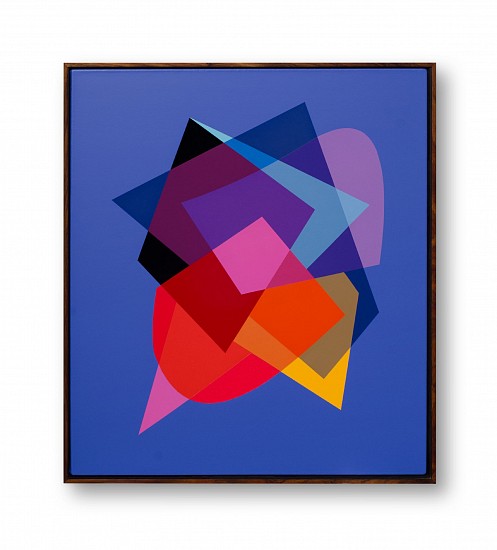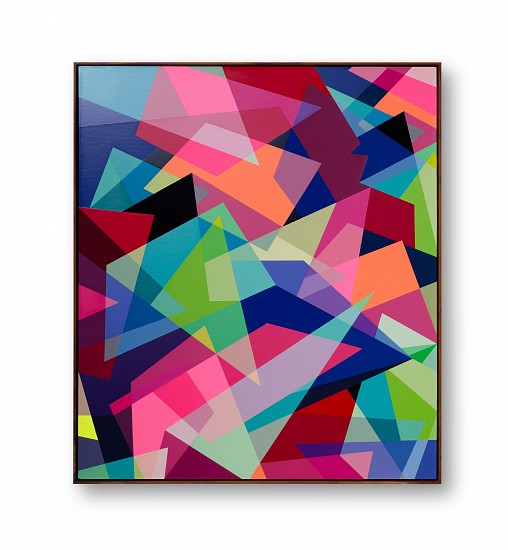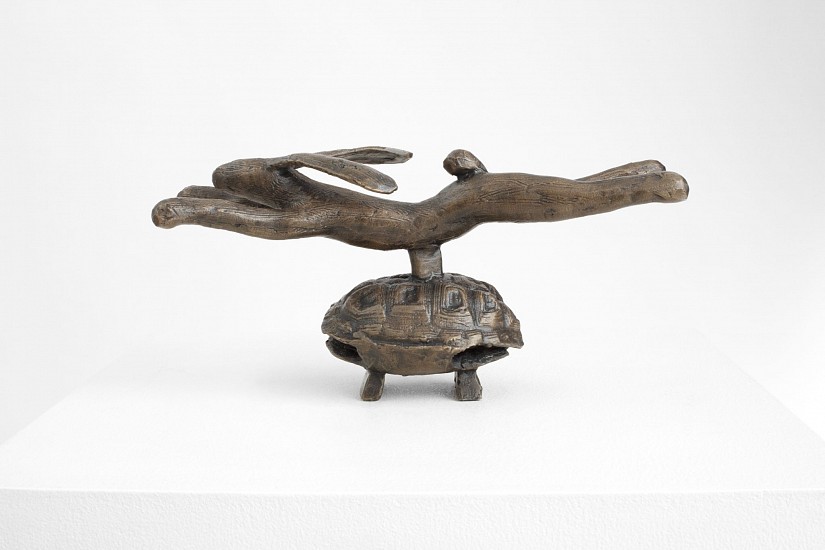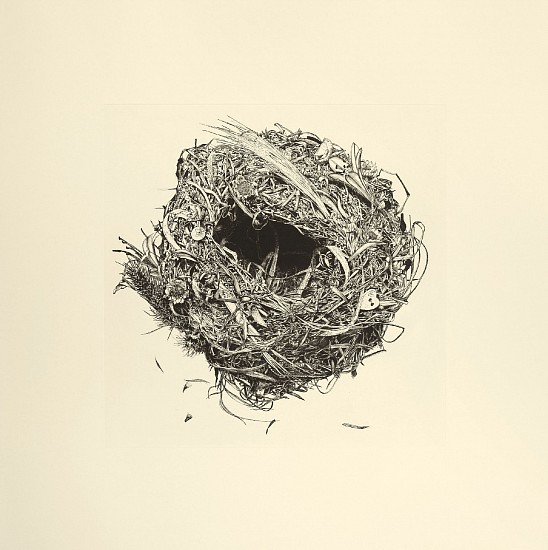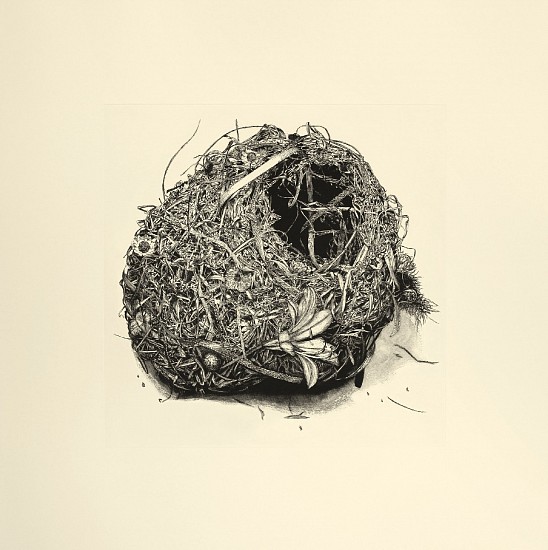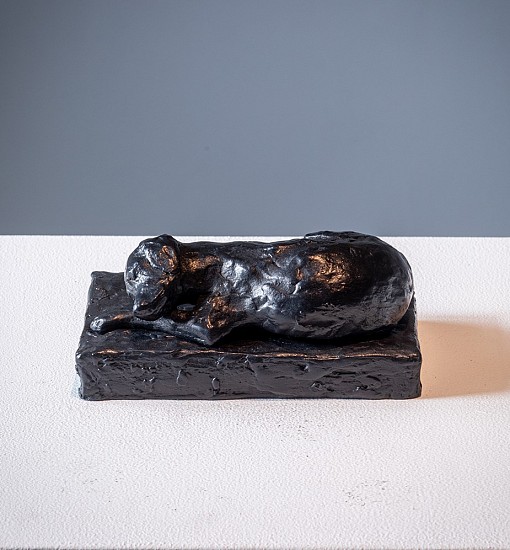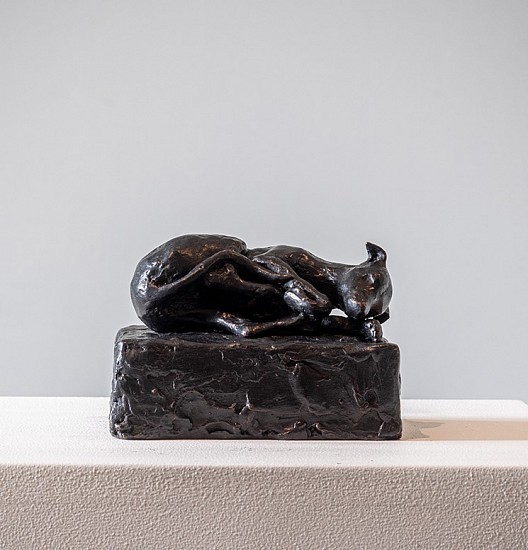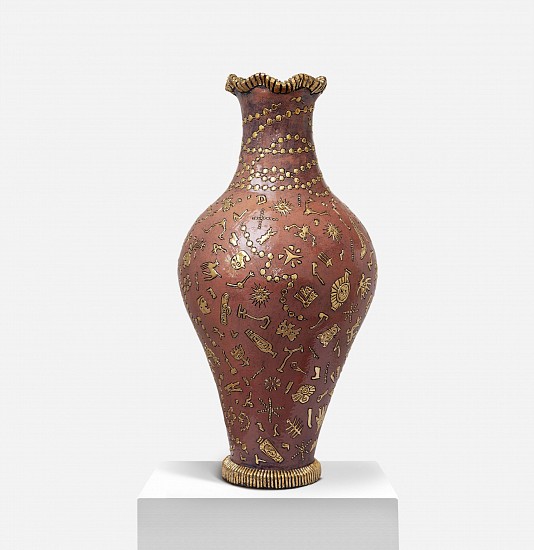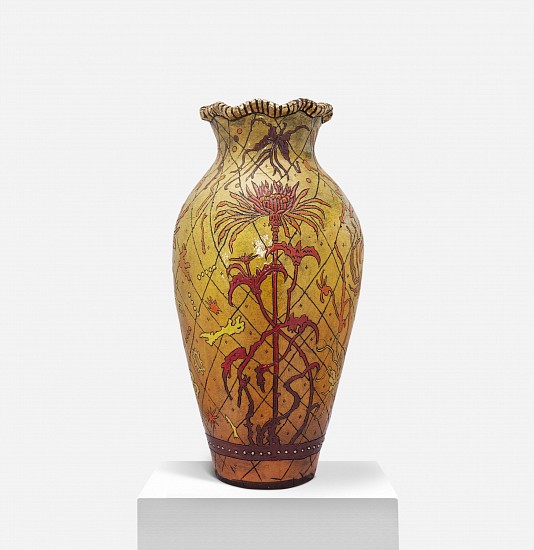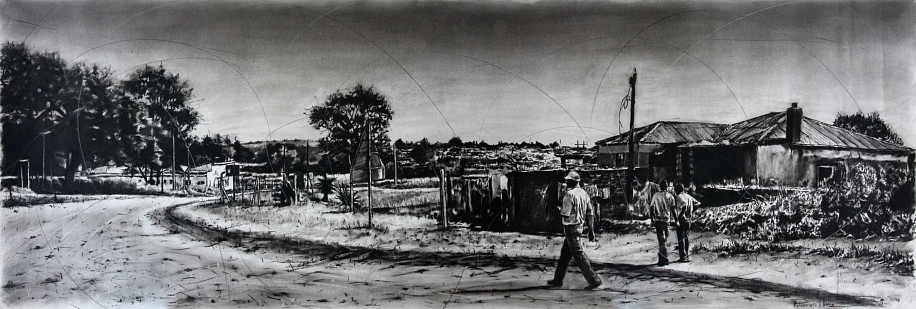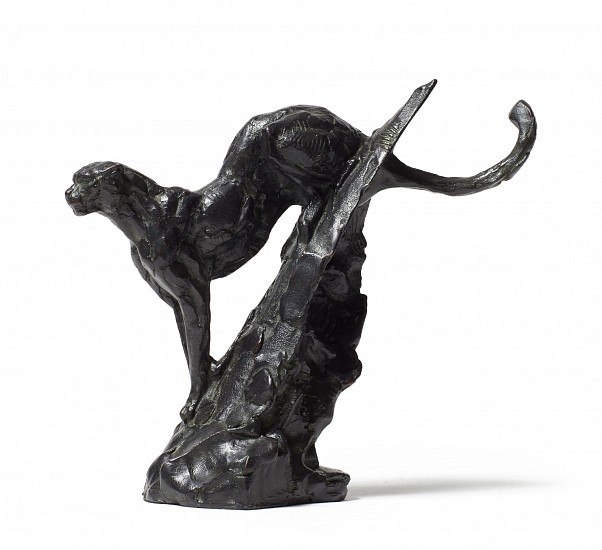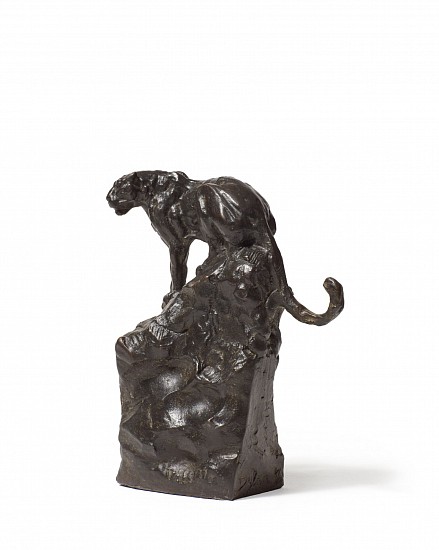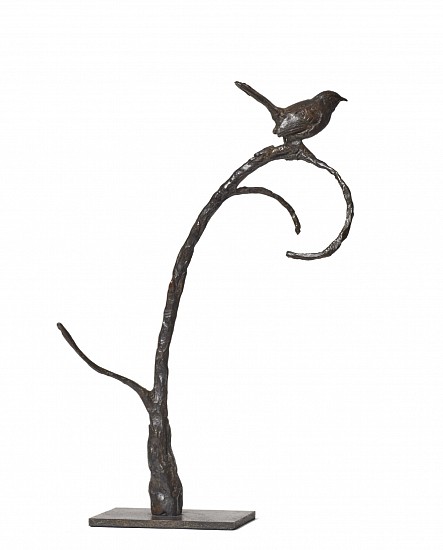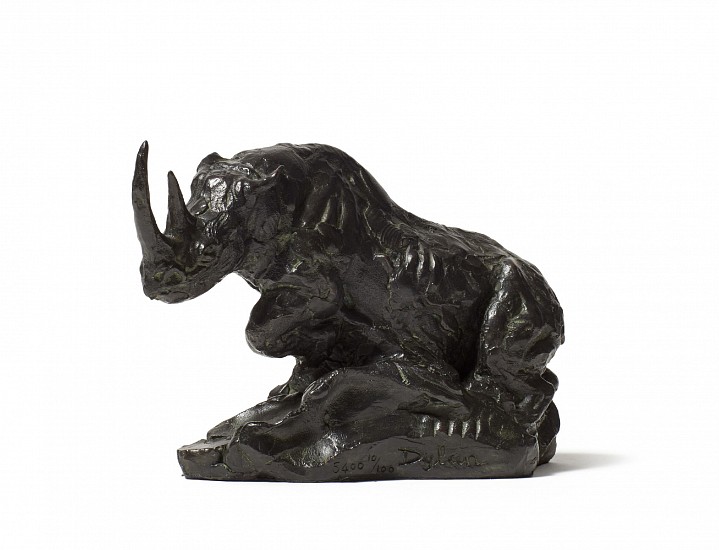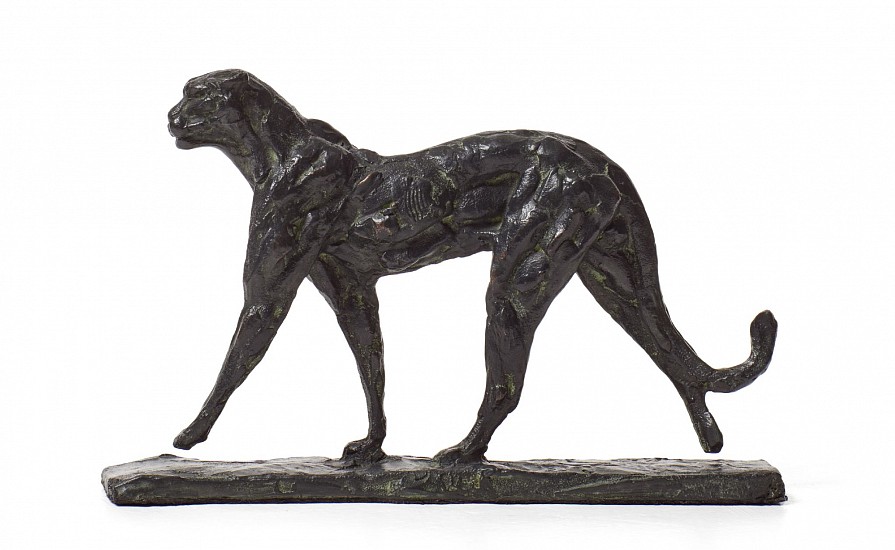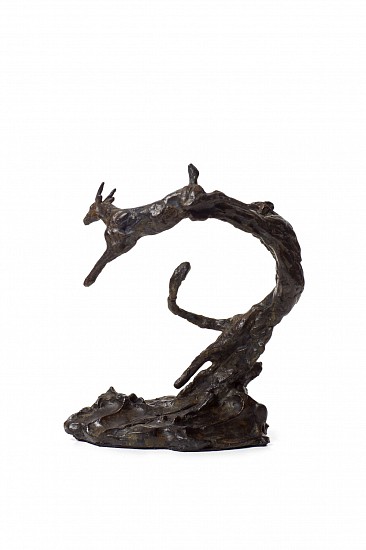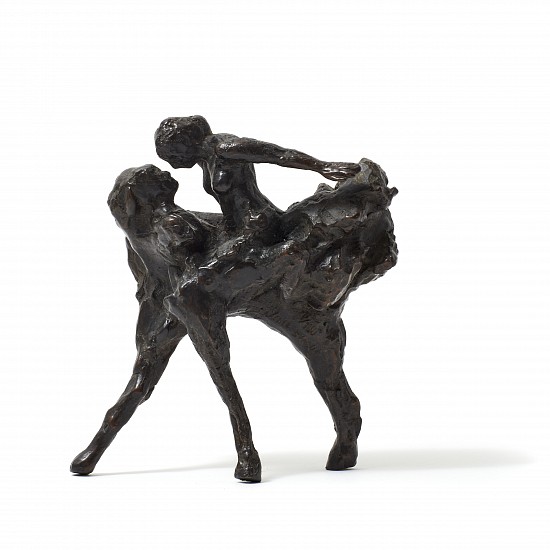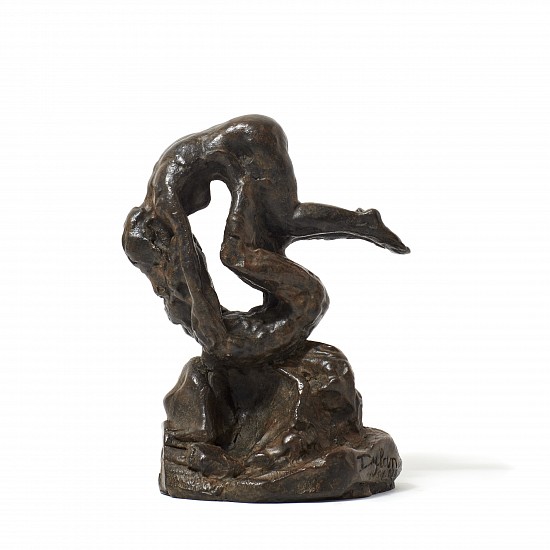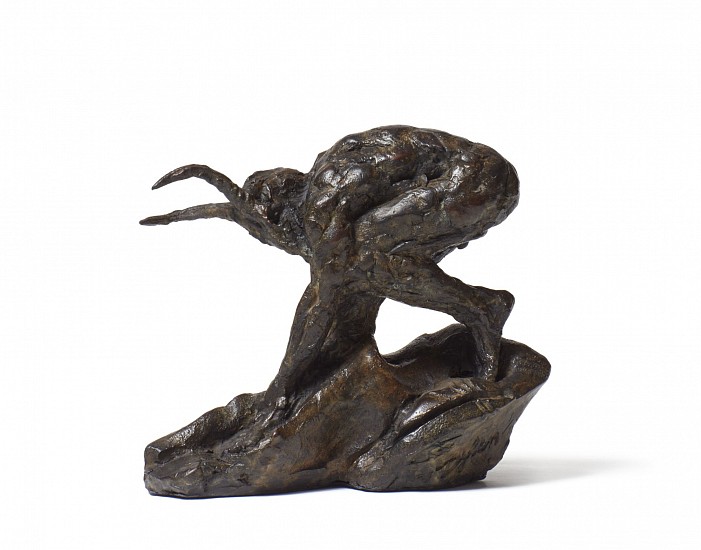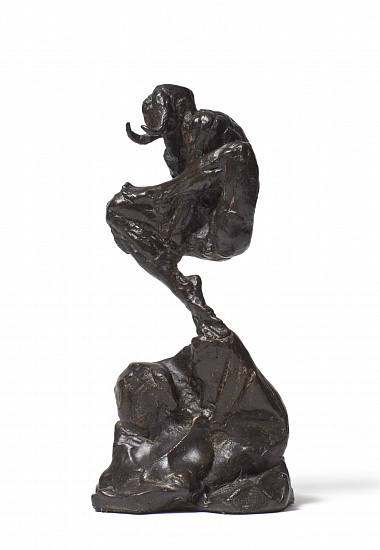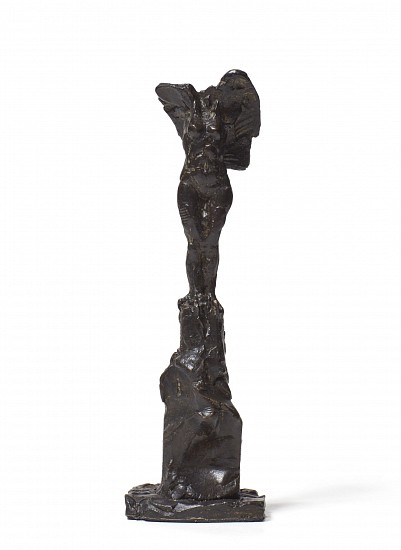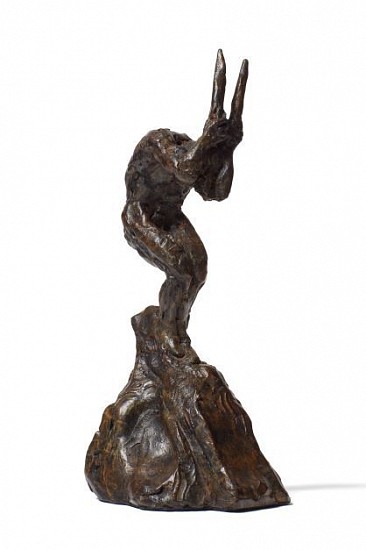WINTER 24/25



CATHY ABRAHAM, Alternate loves Indigo
oil on Italian cotton canvas, 144 x 100 cm
Cathy Abraham’s practice is deeply influenced by artists from the Korean Dansaekhwa movement, along with the repetitive incantations of artists such as Roman Opalka and Agnes Martin, among others.
Abraham works systematically with repetitive gestures as a way of thinking through the patterns and experiences that mark our daily existence. The highly developed surfaces of her work consider boundaries between reality, fantasy and illusion.
‘I count brush marks as a form of meditation, allowing the mark of the brush to leave a visual trace as ghosts do. The “ghostings” are composed from an overlapping series of brushmarks. At first laden with paint the brush begins to make its mark yet through the sequence of strokes, its colour diminishes until there is only an unstable, fragmented residue. I cannot be sure what residues haunt and inspire me, as there are so many events I would like to forget, yet I remain aware of these experiences and their after-effects. By repeatedly drawing or painting the seemingly same mark, I am hoping to find expression for the inexpressible, bringing into existence that which is intangible yet felt.’



CATHY ABRAHAM, Tears of fire
oil on Italian cotton canvas, 144 x 100 cm
Cathy Abraham’s practice is deeply influenced by artists from the Korean Dansaekhwa movement, along with the repetitive incantations of artists such as Roman Opalka and Agnes Martin, among others.
Abraham works systematically with repetitive gestures as a way of thinking through the patterns and experiences that mark our daily existence. The highly developed surfaces of her work consider boundaries between reality, fantasy and illusion.
‘I count brush marks as a form of meditation, allowing the mark of the brush to leave a visual trace as ghosts do. The “ghostings” are composed from an overlapping series of brushmarks. At first laden with paint the brush begins to make its mark yet through the sequence of strokes, its colour diminishes until there is only an unstable, fragmented residue. I cannot be sure what residues haunt and inspire me, as there are so many events I would like to forget, yet I remain aware of these experiences and their after-effects. By repeatedly drawing or painting the seemingly same mark, I am hoping to find expression for the inexpressible, bringing into existence that which is intangible yet felt.’


CATHY ABRAHAM, Purple bones II
oil on Italian cotton canvas, 144 x 100 cm
Cathy Abraham’s practice is deeply influenced by artists from the Korean Dansaekhwa movement, along with the repetitive incantations of artists such as Roman Opalka and Agnes Martin, among others.
Abraham works systematically with repetitive gestures as a way of thinking through the patterns and experiences that mark our daily existence. The highly developed surfaces of her work consider boundaries between reality, fantasy and illusion.
‘I count brush marks as a form of meditation, allowing the mark of the brush to leave a visual trace as ghosts do. The “ghostings” are composed from an overlapping series of brushmarks. At first laden with paint the brush begins to make its mark yet through the sequence of strokes, its colour diminishes until there is only an unstable, fragmented residue. I cannot be sure what residues haunt and inspire me, as there are so many events I would like to forget, yet I remain aware of these experiences and their after-effects. By repeatedly drawing or painting the seemingly same mark, I am hoping to find expression for the inexpressible, bringing into existence that which is intangible yet felt.’



CATHY ABRAHAM, Ascending and descending earth
oil on Italian cotton canvas, 144 x 100 cm
Cathy Abraham’s practice is deeply influenced by artists from the Korean Dansaekhwa movement, along with the repetitive incantations of artists such as Roman Opalka and Agnes Martin, among others.
Abraham works systematically with repetitive gestures as a way of thinking through the patterns and experiences that mark our daily existence. The highly developed surfaces of her work consider boundaries between reality, fantasy and illusion.
‘I count brush marks as a form of meditation, allowing the mark of the brush to leave a visual trace as ghosts do. The “ghostings” are composed from an overlapping series of brushmarks. At first laden with paint the brush begins to make its mark yet through the sequence of strokes, its colour diminishes until there is only an unstable, fragmented residue. I cannot be sure what residues haunt and inspire me, as there are so many events I would like to forget, yet I remain aware of these experiences and their after-effects. By repeatedly drawing or painting the seemingly same mark, I am hoping to find expression for the inexpressible, bringing into existence that which is intangible yet felt.’



PENELOPE STUTTERHEIME, Weaver II
Oil on canvas, 75 x 80 cm
Depicting inner landscapes has long been South African artist Penelope Stutterheime’s preoccupation. Drawing inspiration from dreams and the unconscious, her layered and textured oil paintings use impasto and intensely vibrant colour to create mesmerising abstract works.
Stutterheime’s work is highly symbolic. Conveyed through colour and form, the images are a representation of transformation and resolution. Her paintings are a portrayal of her own inner spiritual process and the traversing of personal and collective boundaries. The artist explains further:
‘The work reveals a slow unfolding, which continues still, of finding my voice, my dance, my melody. It is nourished by intense feeling, emotion contained on a white canvas, to be felt, to be experienced, to be read from the place where no words yet lie’.
Stutterheime’s process of making is intuitive and organic, the flat forms she places onto the canvas present a diffused sense of energy. The daughter of a forester, Stutterheime developed her intense love for landscape as a child, growing up in Newlands Forest, Cape Town. She also credits this for her particular and unique love of the colour green and its continuous presence throughout her works, identifying it as a soothing and comforting colour. Stutterheime lives and works in Cape Town. She studied part-time with the artist Simon Stone and the late Bill Ainslie, one of South Africa’s finest abstractionists, but aside from this is largely self-taught. She has participated in solo and group exhibitions consistently over the past thirty years. Her paintings are included in private and corporate collections around the world.



PENELOPE STUTTERHEIME, Weaver III
Oil on canvas, 80 x 80 cm
Depicting inner landscapes has long been South African artist Penelope Stutterheime’s preoccupation. Drawing inspiration from dreams and the unconscious, her layered and textured oil paintings use impasto and intensely vibrant colour to create mesmerising abstract works.
Stutterheime’s work is highly symbolic. Conveyed through colour and form, the images are a representation of transformation and resolution. Her paintings are a portrayal of her own inner spiritual process and the traversing of personal and collective boundaries. The artist explains further:
‘The work reveals a slow unfolding, which continues still, of finding my voice, my dance, my melody. It is nourished by intense feeling, emotion contained on a white canvas, to be felt, to be experienced, to be read from the place where no words yet lie’.
Stutterheime’s process of making is intuitive and organic, the flat forms she places onto the canvas present a diffused sense of energy. The daughter of a forester, Stutterheime developed her intense love for landscape as a child, growing up in Newlands Forest, Cape Town. She also credits this for her particular and unique love of the colour green and its continuous presence throughout her works, identifying it as a soothing and comforting colour. Stutterheime lives and works in Cape Town. She studied part-time with the artist Simon Stone and the late Bill Ainslie, one of South Africa’s finest abstractionists, but aside from this is largely self-taught. She has participated in solo and group exhibitions consistently over the past thirty years. Her paintings are included in private and corporate collections aroun




TENIQUA CRAWFORD, Meditation
Bronze, 38 x 21 x 21 cm
Teniqua Crawford is a multidisciplinary artist. Her work explores the human condition and its ephemeral nature through the female form. Crawford’s paintings of the figure captured in natural light are an expression of our pure being and essence. Her contained, muted, fragments serve as poetic symbols of the human condition.
Crawford paints and sculpts her subject from life while drawing from her inner world. Her creative process combines observation, memory, imagination and subconscious elements. Mark making resonates with her as an attempt to capture and give form to the ephemeral. She creates a sense of stillness, silence, and solitude in her works, drawn to these qualities as a pathway to the inner self. She has recently been creating abstracted figures in states of emergence that explore the interplay of presence and absence.
Her exploration of the human form as landscape seeks to connect humanity to the natural world. Her connection to nature is inspired by growing up along South Africa’s wild mountain coastline. The prehistoric Middle stone-age caves in this area shaped her perspective of the nature of time and existence.
Crawford recently exhibited during the 2024 Venice Biennale in major group exhibition Breasts.
Her works are in private collections in America, Asia, Australia, England, Europe, the Middle East and South Africa. She received a Bachelor of Arts from Princeton University and a Master of Fine Arts from Harvard University at the American Repertory Theatre, and the Moscow Art Theatre Institute [MXAT].



TENIQUA CRAWFORD, Horizon
aquatint, 19 x 14 cm
Teniqua Crawford is a multidisciplinary artist. Her work explores the human condition and its ephemeral nature through the female form. Crawford’s paintings of the figure captured in natural light are an expression of our pure being and essence. Her contained, muted, fragments serve as poetic symbols of the human condition.
Crawford paints and sculpts her subject from life while drawing from her inner world. Her creative process combines observation, memory, imagination and subconscious elements. Mark making resonates with her as an attempt to capture and give form to the ephemeral. She creates a sense of stillness, silence, and solitude in her works, drawn to these qualities as a pathway to the inner self. She has recently been creating abstracted figures in states of emergence that explore the interplay of presence and absence.
Her exploration of the human form as landscape seeks to connect humanity to the natural world. Her connection to nature is inspired by growing up along South Africa’s wild mountain coastline. The prehistoric Middle stone-age caves in this area shaped her perspective of the nature of time and existence.
Crawford recently exhibited during the 2024 Venice Biennale in major group exhibition Breasts.
Her works are in private collections in America, Asia, Australia, England, Europe, the Middle East and South Africa. She received a Bachelor of Arts from Princeton University and a Master of Fine Arts from Harvard University at the American Repertory Theatre, and the Moscow Art Theatre Institute [MXAT].


BRETT CHARLES SEILER, Meg
engraving on painted wood, 30.5 x 29 cm
Through his paintings, Brett Charles Seiler creates an interior world which wavers between desire and anxiety. He explores the male body, domestic space, poetry, Queer history, Biblical symbolism, love and alienation, as well as the possibilities of painting as a medium. His experimentation with material, colour, and line has culminated in a unique and carefully honed style. In his search for materials which are both evocative and easily accessible, Seiler’s early paintings included found objects such as old black-and-white photographs and fabric. Though these objects have mostly been stripped away from his most recent paintings, they have been absorbed as visual strategy. The photographs are present in the snapshot-like, narrative atmosphere of the depicted scenes, and in the colour palette and tones. The interest in fabric can be seen in his treatment of the canvas as an important part of the finished work. The rawness of the surface and the sketched quality of the lines add to the feeling that we are witnessing a brief, urgent moment in time which has passed but been memorialised.
– Khanya Mashabela, writer, curator and artist
Seiler graduated from the Ruth Prowse School of Art in 2015. In addition to his solo exhibitions, Seiler has been included in various group exhibitions and fairs, including a performance piece with Luvuyo Nyawose titled ‘Reading Homophobia’ (2017) at the A4 Arts Foundation in Cape Town, curated by Kemang Wa Lehulere and Zipho Dayile, and the Cologne Art Fair with Galerie Eigen + Art in 2021.


BRETT CHARLES SEILER, Ryan on Chair
engraving on painted wood, 30.5 x 35 cm
Through his paintings, Brett Charles Seiler creates an interior world which wavers between desire and anxiety. He explores the male body, domestic space, poetry, Queer history, Biblical symbolism, love and alienation, as well as the possibilities of painting as a medium. His experimentation with material, colour, and line has culminated in a unique and carefully honed style. In his search for materials which are both evocative and easily accessible, Seiler’s early paintings included found objects such as old black-and-white photographs and fabric. Though these objects have mostly been stripped away from his most recent paintings, they have been absorbed as visual strategy. The photographs are present in the snapshot-like, narrative atmosphere of the depicted scenes, and in the colour palette and tones. The interest in fabric can be seen in his treatment of the canvas as an important part of the finished work. The rawness of the surface and the sketched quality of the lines add to the feeling that we are witnessing a brief, urgent moment in time which has passed but been memorialised.
– Khanya Mashabela, writer, curator and artist
Seiler graduated from the Ruth Prowse School of Art in 2015. In addition to his solo exhibitions, Seiler has been included in various group exhibitions and fairs, including a performance piece with Luvuyo Nyawose titled ‘Reading Homophobia’ (2017) at the A4 Arts Foundation in Cape Town, curated by Kemang Wa Lehulere and Zipho Dayile, and the Cologne Art Fair with Galerie Eigen + Art in 2021.


BRETT CHARLES SEILER, Nicholas Likes to Skate
engraving on painted wood, 30.5 x 26 cm
Through his paintings, Brett Charles Seiler creates an interior world which wavers between desire and anxiety. He explores the male body, domestic space, poetry, Queer history, Biblical symbolism, love and alienation, as well as the possibilities of painting as a medium. His experimentation with material, colour, and line has culminated in a unique and carefully honed style. In his search for materials which are both evocative and easily accessible, Seiler’s early paintings included found objects such as old black-and-white photographs and fabric. Though these objects have mostly been stripped away from his most recent paintings, they have been absorbed as visual strategy. The photographs are present in the snapshot-like, narrative atmosphere of the depicted scenes, and in the colour palette and tones. The interest in fabric can be seen in his treatment of the canvas as an important part of the finished work. The rawness of the surface and the sketched quality of the lines add to the feeling that we are witnessing a brief, urgent moment in time which has passed but been memorialised.
– Khanya Mashabela, writer, curator and artist
Seiler graduated from the Ruth Prowse School of Art in 2015. In addition to his solo exhibitions, Seiler has been included in various group exhibitions and fairs, including a performance piece with Luvuyo Nyawose titled ‘Reading Homophobia’ (2017) at the A4 Arts Foundation in Cape Town, curated by Kemang Wa Lehulere and Zipho Dayile, and the Cologne Art Fair with Galerie Eigen + Art in 2021.


BRETT CHARLES SEILER, Ryan Looks to the Side
engraving on painted wood, 57 x 30.5 cm
Through his paintings, Brett Charles Seiler creates an interior world which wavers between desire and anxiety. He explores the male body, domestic space, poetry, Queer history, Biblical symbolism, love and alienation, as well as the possibilities of painting as a medium. His experimentation with material, colour, and line has culminated in a unique and carefully honed style. In his search for materials which are both evocative and easily accessible, Seiler’s early paintings included found objects such as old black-and-white photographs and fabric. Though these objects have mostly been stripped away from his most recent paintings, they have been absorbed as visual strategy. The photographs are present in the snapshot-like, narrative atmosphere of the depicted scenes, and in the colour palette and tones. The interest in fabric can be seen in his treatment of the canvas as an important part of the finished work. The rawness of the surface and the sketched quality of the lines add to the feeling that we are witnessing a brief, urgent moment in time which has passed but been memorialised.
– Khanya Mashabela, writer, curator and artist
Seiler graduated from the Ruth Prowse School of Art in 2015. In addition to his solo exhibitions, Seiler has been included in various group exhibitions and fairs, including a performance piece with Luvuyo Nyawose titled ‘Reading Homophobia’ (2017) at the A4 Arts Foundation in Cape Town, curated by Kemang Wa Lehulere and Zipho Dayile, and the Cologne Art Fair with Galerie Eigen + Art in 2021.


BRETT CHARLES SEILER, Willem, Again
engraving on painted wood, 30.5 x 22.5 cm
Through his paintings, Brett Charles Seiler creates an interior world which wavers between desire and anxiety. He explores the male body, domestic space, poetry, Queer history, Biblical symbolism, love and alienation, as well as the possibilities of painting as a medium. His experimentation with material, colour, and line has culminated in a unique and carefully honed style. In his search for materials which are both evocative and easily accessible, Seiler’s early paintings included found objects such as old black-and-white photographs and fabric. Though these objects have mostly been stripped away from his most recent paintings, they have been absorbed as visual strategy. The photographs are present in the snapshot-like, narrative atmosphere of the depicted scenes, and in the colour palette and tones. The interest in fabric can be seen in his treatment of the canvas as an important part of the finished work. The rawness of the surface and the sketched quality of the lines add to the feeling that we are witnessing a brief, urgent moment in time which has passed but been memorialised.
– Khanya Mashabela, writer, curator and artist
Seiler graduated from the Ruth Prowse School of Art in 2015. In addition to his solo exhibitions, Seiler has been included in various group exhibitions and fairs, including a performance piece with Luvuyo Nyawose titled ‘Reading Homophobia’ (2017) at the A4 Arts Foundation in Cape Town, curated by Kemang Wa Lehulere and Zipho Dayile, and the Cologne Art Fair with Galerie Eigen + Art in 2021.



LEE-ANN HEATH, Tuuu-lips
Oil on canvas, 135 x 75 cm
Lee-Ann Heath’s lush botanical paintings stem from her love of impasto and nature. Using her surroundings as a point of departure, Heath draws on inspiration both natural and relational. Heath’s goal is to recreate, analyse and deconstruct sensation.
When working with thick paint, the challenge of finding the balance between confident brush and palette knife strokes and moments of vulnerability, becomes integral to Heath’s process, with the continuous rearrangements of colours and forms lifting and enhancing each other, layer upon layer. The work reflects an obsessive urge to find the ‘right’ combination of colour, line and shape. As Heath explains: ‘I find the elements of surprise and unexpected accidental moments exciting, and when the accidental meets the intentional it often leads to the identity of the work coming into its own.’
Heath’s canvases have the distinctive mark of the artist’s hand; the thickly layered paint has been manipulated in a sensuous manner by her palms or fingers. This technique gives the images a three dimensional, almost culinary quality, the paint’s appearance reminiscent of icing on a cake – and almost good enough to eat. This invitation to an intense sensory interaction is carried through Heath’s practice, making her artworks textured, tactile and dynamic.


LEE-ANN HEATH, Hello Yellow
Oil on canvas, 110 x 150 cm
Lee-Ann Heath’s lush botanical paintings stem from her love of impasto and nature. Using her surroundings as a point of departure, Heath draws on inspiration both natural and relational. Heath’s goal is to recreate, analyse and deconstruct sensation.
When working with thick paint, the challenge of finding the balance between confident brush and palette knife strokes and moments of vulnerability, becomes integral to Heath’s process, with the continuous rearrangements of colours and forms lifting and enhancing each other, layer upon layer. The work reflects an obsessive urge to find the ‘right’ combination of colour, line and shape. As Heath explains: ‘I find the elements of surprise and unexpected accidental moments exciting, and when the accidental meets the intentional it often leads to the identity of the work coming into its own.’
Heath’s canvases have the distinctive mark of the artist’s hand; the thickly layered paint has been manipulated in a sensuous manner by her palms or fingers. This technique gives the images a three dimensional, almost culinary quality, the paint’s appearance reminiscent of icing on a cake – and almost good enough to eat. This invitation to an intense sensory interaction is carried through Heath’s practice, making her artworks textured, tactile and dynamic.


LIONEL SMIT, Reversible
Oil on linen, 150 x 120 cm (59 x 47 1/8 in.)
Lionel Smit is best known for his contemporary portraiture executed through monumental canvases and sculptures. A multidisciplinary artist, each of Smit’s works offers us an entry point into the variety and richness that lies beneath every face we encounter in life, whether applied in bronze or in paint. While retaining their austerity and meditative aesthetic, Smit’s figures remain highly charged with the emotive and gestural energy of his creative process.
Smit’s paintings begin with abstract lines and swathes of colour that establish a foundation for the subsequently overlaid image of a face or bust – in most cases of anonymous models from the Cape Malay community. For Smit, the Cape Malay woman epitomises hybrid identity within a South African context and reflects the fragmentation of identity within our increasingly globalised world.
Smit’s process as an artist today remains adaptive, inventive, and physically engaging and he has achieved success internationally, from Hong Kong to London and New York. Smit’s painting has been exhibited at the National Portrait Gallery in London where it received the Viewer’s Choice Award, as well as selected as the ‘face’ of the BP Portrait Award 2013. In 2016, Smit, in collaboration with Cynthia-Reeves Gallery, installed a public art installation, ‘Morphous’, in New York’s Union Square. He received a Ministerial Award from the South African Department of Culture for Visual Art.
ANNE GRAAFF, Cedar Peak - Sounds of the Veld IV
ink and wash on 300 gram watercolour paper, 66.8 x 85.8 cm
Anne Graaff is an artist, art historian and poet living in France, whose work is influenced by research on contemporary book art, and her own contribution to artist’s books. As an art historian, Graaff has specialized in Outsider Art, writing two books published by Penguin, South Africa, under the pseudonym, Anne Emslie. In 2017 Graaff republished The Owl House, a book about the renowned South African Outsider artist, Helen Martins.
Recent exhibitions of Graaff’s artist’s books and paintings include Elles métamorphosent le Livre II at Espace des Femmes gallery, Paris; a solo exhibition of artists books at Atelier de la Main d’Or, Paris; and work in the group shows at la Porte Peintre, France, as well as galleries in South Africa.
Graaff’s poetry has been published in numerous publications such as Carapace, Stanzas, the anthologies of African poetry, Africa, My Africa! and Absolute Africa! This is Graaff’s debut exhibition with the Everard Read galleries.


ANNE GRAAFF, Cedar Peak - Sounds of the Veld III
ink and wash on 300 gram watercolour paper, 66.5 x 86.1 cm
Anne Graaff is an artist, art historian and poet living in France, whose work is influenced by research on contemporary book art, and her own contribution to artist’s books. As an art historian, Graaff has specialized in Outsider Art, writing two books published by Penguin, South Africa, under the pseudonym, Anne Emslie. In 2017 Graaff republished The Owl House, a book about the renowned South African Outsider artist, Helen Martins.
Recent exhibitions of Graaff’s artist’s books and paintings include Elles métamorphosent le Livre II at Espace des Femmes gallery, Paris; a solo exhibition of artists books at Atelier de la Main d’Or, Paris; and work in the group shows at la Porte Peintre, France, as well as galleries in South Africa.
Graaff’s poetry has been published in numerous publications such as Carapace, Stanzas, the anthologies of African poetry, Africa, My Africa! and Absolute Africa! This is Graaff’s debut exhibition with the Everard Read galleries.


ANNE GRAAFF, Cedar Peak - Sounds of the Veld II
ink and wash on 300 gram watercolour paper, 66.4 x 86 cm
Anne Graaff is an artist, art historian and poet living in France, whose work is influenced by research on contemporary book art, and her own contribution to artist’s books. As an art historian, Graaff has specialized in Outsider Art, writing two books published by Penguin, South Africa, under the pseudonym, Anne Emslie. In 2017 Graaff republished The Owl House, a book about the renowned South African Outsider artist, Helen Martins.
Recent exhibitions of Graaff’s artist’s books and paintings include Elles métamorphosent le Livre II at Espace des Femmes gallery, Paris; a solo exhibition of artists books at Atelier de la Main d’Or, Paris; and work in the group shows at la Porte Peintre, France, as well as galleries in South Africa.
Graaff’s poetry has been published in numerous publications such as Carapace, Stanzas, the anthologies of African poetry, Africa, My Africa! and Absolute Africa! This is Graaff’s debut exhibition with the Everard Read galleries.
ANNE GRAAFF, Cedar Peak - Sounds of the Veld I
ink and wash on 300 gram watercolour paper, 66.3 x 86.1 cm
Anne Graaff is an artist, art historian and poet living in France, whose work is influenced by research on contemporary book art, and her own contribution to artist’s books. As an art historian, Graaff has specialized in Outsider Art, writing two books published by Penguin, South Africa, under the pseudonym, Anne Emslie. In 2017 Graaff republished The Owl House, a book about the renowned South African Outsider artist, Helen Martins.
Recent exhibitions of Graaff’s artist’s books and paintings include Elles métamorphosent le Livre II at Espace des Femmes gallery, Paris; a solo exhibition of artists books at Atelier de la Main d’Or, Paris; and work in the group shows at la Porte Peintre, France, as well as galleries in South Africa.
Graaff’s poetry has been published in numerous publications such as Carapace, Stanzas, the anthologies of African poetry, Africa, My Africa! and Absolute Africa! This is Graaff’s debut exhibition with the Everard Read galleries.



GITHAN COOPOO, In Sorrow and Bliss
CLAY AND ACRYLIC, 53 x 37 x 15 cm
‘Clay is very human in its behaviour, and I like to highlight that in my work. Each sculpture I create feels like a placeholder for my own body, or a facet of myself. This is met with a love for mythology, ancient civilisations and the gifts they have left us in the form of social and cultural iconography. There is something special about objects that are lost and then found again in their disruption of our linear understanding of time. In a similar vein, mythology often allows for an easier transmission of queer ideas.’
Githan Coopoo is a self-taught jewellery designer and sculptor from Cape Town who works exclusively with clay as a base medium. Originally focused on volume, opulence and fragility, Coopoo’s clay jewellery has shown at Fashion Weeks internationally, including New York, Paris, Nigeria and Russia. He was AKO Foundation Assistant Curator of Costume at the Zeitz MOCAA in Cape Town. In 2022, Coopoo was recognised by the British Fashion Council in their New Wave: Creatives awards category. This category includes a list of the most innovative and inspiring young creative talents from around the world.
Expanding upon his practice, recent years have seen Coopoo create larger-scale works, best described as false ceramics. ‘I produce these iconic forms – vases, handbags and tiles – out of air drying clay and acrylic paint,’ Coopoo explains. ‘Insinuating my sculptures into the accepted ceramic canon while enacting a falsehood is an innately queer act.’
The sculptural forms use text to communicate simple but pointed messages that span from sarcastic to intimate in timbre. Using humour to disable elitism and intellectual inaccessibility, Coopoo’s work is not afraid to wield popular notions of cultural exclusivity in the name of satire. He comments: ‘I work with words and clauses carved into the faces of my pieces because written languages diminish the conversational chasm between myself and my audience. They deepen the sense of relatability and familiarity, with the opportunity to also imbue wholly new meaning and identity to the work.’ As part of the inaugural exhibition for the Norval Foundation x Boschendal Manor House in Franschhoek, South Africa, Coopoo presented his first solo exhibition in 2021. Coopoo’s solo show with Everard Read Cape Town in 2022, explored luxury consumption in both art and fashion, while again being bolstered by base and colourful remarks teetering between the existential and tongue-and-cheek. Everard Read presented Coopoo’s work at the FNB Art Joburg fair in 2022. He began 2023 with a sold-out solo booth at the Investec Cape Town Art Fair, as well as two sold-out presentations, in Berlin with Galerie Eigen + Art Lab, and Everard Read in Johannesburg.



GITHAN COOPOO, How do you live?
CLAY AND ACRYLIC, 55 x 49 x 15 cm
‘Clay is very human in its behaviour, and I like to highlight that in my work. Each sculpture I create feels like a placeholder for my own body, or a facet of myself. This is met with a love for mythology, ancient civilisations and the gifts they have left us in the form of social and cultural iconography. There is something special about objects that are lost and then found again in their disruption of our linear understanding of time. In a similar vein, mythology often allows for an easier transmission of queer ideas.’
Githan Coopoo is a self-taught jewellery designer and sculptor from Cape Town who works exclusively with clay as a base medium. Originally focused on volume, opulence and fragility, Coopoo’s clay jewellery has shown at Fashion Weeks internationally, including New York, Paris, Nigeria and Russia. He was AKO Foundation Assistant Curator of Costume at the Zeitz MOCAA in Cape Town. In 2022, Coopoo was recognised by the British Fashion Council in their New Wave: Creatives awards category. This category includes a list of the most innovative and inspiring young creative talents from around the world.
Expanding upon his practice, recent years have seen Coopoo create larger-scale works, best described as false ceramics. ‘I produce these iconic forms – vases, handbags and tiles – out of air drying clay and acrylic paint,’ Coopoo explains. ‘Insinuating my sculptures into the accepted ceramic canon while enacting a falsehood is an innately queer act.’
The sculptural forms use text to communicate simple but pointed messages that span from sarcastic to intimate in timbre. Using humour to disable elitism and intellectual inaccessibility, Coopoo’s work is not afraid to wield popular notions of cultural exclusivity in the name of satire. He comments: ‘I work with words and clauses carved into the faces of my pieces because written languages diminish the conversational chasm between myself and my audience. They deepen the sense of relatability and familiarity, with the opportunity to also imbue wholly new meaning and identity to the work.’ As part of the inaugural exhibition for the Norval Foundation x Boschendal Manor House in Franschhoek, South Africa, Coopoo presented his first solo exhibition in 2021. Coopoo’s solo show with Everard Read Cape Town in 2022, explored luxury consumption in both art and fashion, while again being bolstered by base and colourful remarks teetering between the existential and tongue-and-cheek. Everard Read presented Coopoo’s work at the FNB Art Joburg fair in 2022. He began 2023 with a sold-out solo booth at the Investec Cape Town Art Fair, as well as two sold-out presentations, in Berlin with Galerie Eigen + Art Lab, and Everard Read in Johannesburg.



FLORIAN WOZNIAK, Dreamer (small maquette)
Bronze, 17.5 x 11.5 x 9 cm
For more than three decades Florian Wozniak has worked independently as a contemporary artist in South Africa. Working primarily in bronze, the artist’s smooth, figurative forms feel rooted to the earth and convey a powerful serenity. His sculptures are by turns tender and endearing, playful and witty; his characters often evoking pathos or humour.
Wozniak seeks transcendence through his work, a release from the constraints of the corporeal. This counterpoint is explored in the interplay between mass, weight, volume, and structure on the one hand, and fluidity, motion and grace on the other. Wozniak’s Dreamer curls in on himself but his gaze his skywards.
Optimism is implicit in every piece Wozniak sculpts and is palpable in the finished object. It is no surprise that he identifies so strongly with the sentiment of 20th century, Italian sculptor, Arturo Martini, when he said, ‘In this Babylon, where everyone has lost [their] senses, my sculpture could bring them some joy in its clarity and vibracy.'


FLORIAN WOZNIAK, Seated Woman
Bronze, 24 x 20 x 17 cm
For more than three decades Florian Wozniak has worked independently as a contemporary artist in South Africa. Working primarily in bronze, the artist’s smooth, figurative forms feel rooted to the earth and convey a powerful serenity. His sculptures are by turns tender and endearing, playful and witty; his characters often evoking pathos or humour.
Wozniak seeks transcendence through his work, a release from the constraints of the corporeal. This counterpoint is explored in the interplay between mass, weight, volume, and structure on the one hand, and fluidity, motion and grace on the other. Wozniak’s Dreamer curls in on himself but his gaze his skywards.
Optimism is implicit in every piece Wozniak sculpts and is palpable in the finished object. It is no surprise that he identifies so strongly with the sentiment of 20th century, Italian sculptor, Arturo Martini, when he said, ‘In this Babylon, where everyone has lost [their] senses, my sculpture could bring them some joy in its clarity and vibracy.'


MATTHEW HINDLEY, Chapter One
Oil on canvas, 75 x 101 cm
Matthew Hindley’s artistic focus has grown and developed from portraiture to abstraction and most recently the exploration of landscape. Over time subjects have developed from and continue to bleed into one another as Hindley hones his skills and builds experience.
A residency at the gardens and wetlands of Leeu Estates in Franschhoek, South Africa, provided inspiration for this new departure, and Hindley continues the series, exploring landscapes of personal significance to him: the view from his former studio, the road where he currently lives, the forest he and his daughter visited on holiday.
Hindley refers to these works as Memoryscapes – the scenes are laden with his personal memories as well as the significance assigned to them from the wider communities who treasure and protect the important places of outstanding natural beauty. Vibrant, luminous and teeming with life, the paintings do not claim ownership of the landscapes but rather proclaim an intense love for their subjects.


MATTHEW HINDLEY, The Unsaid
Oil on canvas, 91 x 91 cm
Matthew Hindley’s artistic focus has grown and developed from portraiture to abstraction and most recently the exploration of landscape. Over time subjects have developed from and continue to bleed into one another as Hindley hones his skills and builds experience.
A residency at the gardens and wetlands of Leeu Estates in Franschhoek, South Africa, provided inspiration for this new departure, and Hindley continues the series, exploring landscapes of personal significance to him: the view from his former studio, the road where he currently lives, the forest he and his daughter visited on holiday.
Hindley refers to these works as Memoryscapes – the scenes are laden with his personal memories as well as the significance assigned to them from the wider communities who treasure and protect the important places of outstanding natural beauty. Vibrant, luminous and teeming with life, the paintings do not claim ownership of the landscapes but rather proclaim an intense love for their subjects.



MATTHEW HINDLEY, Death Closes All
oil and acrylic on Italian Cotton, 133 x 95 cm
Matthew Hindley’s artistic focus has grown and developed from portraiture to abstraction and most recently the exploration of landscape. Over time subjects have developed from and continue to bleed into one another as Hindley hones his skills and builds experience.
A residency at the gardens and wetlands of Leeu Estates in Franschhoek, South Africa, provided inspiration for this new departure, and Hindley continues the series, exploring landscapes of personal significance to him: the view from his former studio, the road where he currently lives, the forest he and his daughter visited on holiday.
Hindley refers to these works as Memoryscapes – the scenes are laden with his personal memories as well as the significance assigned to them from the wider communities who treasure and protect the important places of outstanding natural beauty. Vibrant, luminous and teeming with life, the paintings do not claim ownership of the landscapes but rather proclaim an intense love for their subjects.


DEBORAH BELL, Silence of Stone
Bronze, 54 x 15 x 13 cm
Deborah Bell is one of South Africa’s most celebrated contemporary artists. She works in a range of media on canvas and paper, produces dry point etchings and large-scale bronzes. Her earlier more political work has given way to a broader, deeper investigation into the border between mortality and immortality, matter and spirit, presence and absence, the quotidian and the mythic, the grounded and transcendent. In recent years she has developed an immediately recognisable visual language, her images simple, stark, symbolic – grounded, silent, still, poised.
In her iconography she draws from a range of cultures (including African, Chinese, Egyptian, Greek, early Christian and European) and a range of philosophies (especially the Buddhist preoccupation with stillness and the shedding of attachment and the ego) and psychologies (more Jung than Freud) – but her work digs deeper, arriving finally out of an internal and personal place that Bell occupies in the world as an artist, a woman and an explorer. A central task is to make the unknown present – apprehended in a series of powerful images that are both of her and beyond her.
Bell’s earlier figures, characterised by entrapment (in the country, in the body), gave away to figures embodying the seeker – often accompanied by boats, horses, chariots. Images of lions, dogs, horses and angels recur. These are often intermediary figures between the physical world and a higher more spiritual realm. They are also aspects of herself – the powerful daemons that reside in all of us, which are often accompanied by solitary female figures, some full of assertive confidence, others more vulnerable and less sure of their agency.
Bell is interested in the half-formed image – the unwritten, as yet unformed spaces we move towards in our quest for self-knowledge. Her recent work has also become more concerned with surrender – to the higher self, the mystery of the universe, the simplicity of the present. All her art, she has stated, works towards the Zen mark: the single gesture of absolute presence. Her quest is ongoing – and has left in its wake a series of hugely powerful, totemic images from what Yeats called Spiritus Mundi.
Bell has worked with a great variety of media during her career and has collaborated on various historically significant projects with contemporaries such as William Kentridge and Robert Hodgins.




JOHN MURRAY, Barred
Acrylic on canvas, 55 x 45 cm
John Murray is a South African painter living and working in Cape Town. Finding significance in the contrasting states between the tangible and the imperceptible, playfulness and seriousness, Murray moves between representational and nonrepresentational forms.
Working in oil on canvas as well as in collage and bricolage, the images used in his compositions are often interpretations of found objects and photographs. Some of these images have specific cultural, historical or political significance, while others are trivia collected from the artist’s everyday surroundings. These composite images or compositions prompt viewerspecific responses and associations, with the juxtaposition of images acting as triggers or catalysts for meaning.
More recently Murray’s work has leaned towards abstraction, not in its purest sense but rendered in a way that still hints at representational forms beneath the surface. These works, originally inspired by the different colours and hues that accumulated on the artists mixing palettes whilst working, have evolved into a series of paintings that allude to structures that simultaneously appear to be in the process of forming and disintegrating.
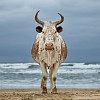


DANIEL NAUDÉ, Xhosa Nguni cow on the shore. Kiwane, Eastern Cape, South Africa, 5 April 2018
110 x 110 cm
Daniel Naudé lives and works in Stellenbosch, South Africa. He graduated with a BA Visual Arts Honours degree from the University of Stellenbosch in 2007. Naudé has had solo exhibitions at Everard Read galleries in London, Cape Town, Johannesburg and at The Photographers’ Gallery in London.
Naudé’s first book, Animal Farm, was published in 2012, followed by Sightings of the Sacred: Cattle in India, Uganda and Madagascar in 2016. In 2017 Daniel Naudé published a book together with South African President, Cyril Ramaphosa, – Cattle of the Ages. Naudé took part in a residency programme at Anderson Ranch in Aspen, Colorado (2011).


KILMANY-JO LIVERSAGE, FLORELL
acrylic, aerosol spray and marker on 300g Fabriano archival paper, 76 x 57 cm
Kilmany-Jo Liversage creates portraits that intentionally blur the boundary between fine art and street art. Her rendering of female subjects is inspired by Renaissance-era portraiture and, by adopting the language of graffiti or urban art, she updates, renews and challenges the conventions of painting. Her work also references digitised mass production and a futuristic post-human world, populated by perfect-looking female cyborgs. The result is a series of vivid, large-format paintings which evoke the street, the history of art and a vision of the future.
‘I feel strongly about the role women play in our society and am interested in portraying the strength and Femme fatalism of women in my portraits and still-lives. The role of matriarch has gained impetus through the digital age. Empowerment, transformation and a greater emphasis on gender-equality has created a global shift in how femininity is perceived and how contemporary women are portrayed.’



KILMANY-JO LIVERSAGE, LINGA
acrylic, aerosol spray and marker on canvas, 76.5 x 52 cm
Kilmany-Jo Liversage creates portraits that intentionally blur the boundary between fine art and street art. Her rendering of female subjects is inspired by Renaissance-era portraiture and, by adopting the language of graffiti or urban art, she updates, renews and challenges the conventions of painting. Her work also references digitised mass production and a futuristic post-human world, populated by perfect-looking female cyborgs. The result is a series of vivid, large-format paintings which evoke the street, the history of art and a vision of the future.
‘I feel strongly about the role women play in our society and am interested in portraying the strength and Femme fatalism of women in my portraits and still-lives. The role of matriarch has gained impetus through the digital age. Empowerment, transformation and a greater emphasis on gender-equality has created a global shift in how femininity is perceived and how contemporary women are portrayed.’


ANGUS TAYLOR, Entangled Head: Layered
Bronze and various stone: Green Quartz, Bloodstone, Dolomite, Hematite, Belfast Granite and Grey Chert, 67 x 31 x 19 cm
Angus Taylor is one of South Africa’s foremost sculptors and is known for his powerful, sculptural works made from materials from his immediate environment – Belfast granite, red Jasper and the orange earth found near Johannesburg. Although he references traditional South African crafting techniques, his works are unmistakably contemporary. Taylor’s craftsmanship, bold and visionary approach and his original use of materials has
resulted in many ambitious public and private commissions around the world.
In 1997, Taylor established Dionysus Sculpture Works, a studio and workshop combining all aspects of sculpture production: from conceptualisation to clay modelling, carving to casting. He casts his own and other prominent sculptors’ work including Deborah Bell, Norman Catherine and Sam Nhlenghthwa, and also nurtures the talent of young and developing artists.
In addition to numerous solo and group exhibitions in South Africa and internationally, Taylor is actively involved in national and local government as well as private sector large-scale commissions. These include the Solomon Mahlangu statue in Mamelodi (Pretoria), the statue of Chief Tshwane in front of the Pretoria City Hall as well as the work commemorating South African anti-apartheid Afropop singer, Brenda Fassie, in Newtown, Johannesburg.


ANGUS TAYLOR, Contextual Thinking
bronze and stone
Angus Taylor is one of South Africa’s foremost sculptors and is known for his powerful, sculptural works made from materials from his immediate environment – Belfast granite, red Jasper and the orange earth found near Johannesburg. Although he references traditional South African crafting techniques, his works are unmistakably contemporary. Taylor’s craftsmanship, bold and visionary approach and his original use of materials has resulted in many ambitious public and private commissions around the world.
In 1997, Taylor established Dionysus Sculpture Works, a studio and workshop combining all aspects of sculpture production: from conceptualisation to clay modelling, carving to casting. He casts his own and other prominent sculptors’ work including Deborah Bell, Norman Catherine and Sam Nhlenghthwa, and also nurtures the talent of young and developing artists.
In addition to numerous solo and group exhibitions in South Africa and internationally, Taylor is actively involved in national and local government as well as private sector large-scale commissions. These include the Solomon Mahlangu statue in Mamelodi (Pretoria), the statue of Chief Tshwane in front of the Pretoria City Hall as well as the work commemorating South African anti-apartheid Afropop singer,
Brenda Fassie, in Newtown, Johannesburg.




NIGEL MULLINS, Gay Pride, Sao Paulo
Oil on canvas, 120 x 180 cm
Nigel Mullins’ paintings achieve immediacy and presence through the artist’s thick impasto and use of colour. The paintings take on an almost sculptural quality due to the thick application of paint and Mullins’ tendency to embellish and distress the frames of the works. His work explores the cultural significance of the icon in all its forms, and how cultural iconography has developed from before the Renaissance to the seminal moments of the 20th century.
Mullins has become known for his vivid and compelling scenes of recent and historic gatherings that have become momentous and iconic. His painterly exploration of these crowd scenes makes use of sumptuous impasto, veering between figuration and abstraction. Some of their power lies in their ability to capture the Instagram-able images of mass gatherings that characterise our era. The canvases, with their vertiginous vantage point and lashings of paint, both sensual and viscous, give the sensation of soaring above the crowd.
Mullins’ work has been represented in art fairs in Africa and Europe as well as Mumia International Underground Animation Festival, Brazil. His work is held in public and private collections in South Africa, the UK and Europe.


CHRISTOPHER MARVELL, La vie en rose
Bronze on Oak, 67 x 20 x 26 cm
Christopher Marvell’s work is imbued with his patient observations of the natural world. His whimsical animals, birds, and figures eschew extraneous detail while retaining familiar characteristics and conveying both pathos and humour.
Marvell grew up in Clacton before studying at the University of Newcastle upon Tyne (1982–6). Later he moved to Cambridge and began working in a studio at Fulbourn Manor with artist and designer Majorie Townley. In Cambridge Marvell met his future partner, the painter
Elaine Pamphili, with whom he bought a 400-year-old house which they set about renovating.
Working primarily in Cambridge, Marvell also spends time at his home in St Ives and draws inspiration from both Cornish history and the landscape.
Marvell has exhibited throughout the UK. His work is held in public and private collections in the UK and internationally.
‘Walking daily through the landscapes around the studios gives a constant focus for what I am trying to make. My sculptures have a quiet English based quality of man and nature. In the way that we hear countryside through Britten or Vaughan Williams. It is the business of observing acutely and recording – of searching for the line and shape and images. You have to make art from what you know about – a celebration of locality.’
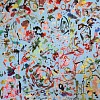

EMALIE BINGHAM, Opening
Mixed media on canvas, 101.6 x 101.6 cm
Emalie Bingham trained as an artist and exhibited for ten years in South Africa before relocating to the UK in 2019. This exposed her to a widened variety of sociopolitical, psychospiritual, and design perspectives within a new environment, further shaping and expanding her creative practice.
Playfully juxtaposing, layering, and collaging marks as repeating motifs, Emalie Bingham’s mixed media work explores endless possible outcomes, and considers a re-writing of normative attitudes towards grouping, orientation, and order.
‘My work is centred around emerging and shifting patterns of transformation, connection, and possibility. Both technically and conceptually, I seek to deconstruct and subvert binary paradigms, towards an alternative narrative of fluidity, possibility, and inclusion. I create, collect, dismantle, and redesign marks as symbols, developing a system of abstract signs through form, material, and process. This particular visual alphabet consists of offcuts, incidental strokes, and more intentional, repetitive explorations of personally significant objects. The compositions impose a kind of visual “dyslexia”, requiring imaginative readings beyond familiar patterning of “language”, and so what each mark represents may depend on interpretation. The emergent abstract designs pose questions and open dialogue around notions of framing, visibility, belonging, transition, chaos, deviance, and perception.’



PHILIPPE UZAC, Gaia III
OIL AND GOLD LEAF ON CANVAS, 150 x 150 cm
Uzac finds beauty in the weathered and rusting cityscape of downtown Johannesburg, where he kept a studio for many years. The patterns and textures resulting from layers of peeling or fading paint serve as inspiration for Uzac – a manifestation of time passing which evokes a sense of nostalgia and melancholy. ‘I look for an aesthetic in decay and try to capture it on canvas,’ says the artist.
Uzac’s works are achieved through repeated layering of oil paint – up to 15 layers painstakingly applied and allowed to dry before the next is added. Using knives, spatulas, wax and sandpaper, he emulates the effects of time by scratching, rubbing and sanding the layers of paint to achieve his signature, textured surfaces.
The artist’s apparently scarred works serve as metaphors for humanity’s futile pursuit of perfection. His process of abstraction has been described as ‘a peeling away of idea of perfection and [the] Western pursuit of man ordering nature – a pursuit that has taken our planet into its present crisis … Uzac peels away all the outer layers to lay bare the scars and imperfections of world around him, and himself.’*
‘My process starts with a layer of black paint’, explains Uzac. ‘Black is the absence of light and evokes the nothingness so dear to Heidegger. But black is also one of the first colours used by man in the neolithic age so although ‘nothing’ is on the canvas at this stage of the process, it carries already the potentiality of ‘everything’.
* Jessica Deutsch, artstolife world, February 2023




WILLIAM PEERS, Ilona ||
Portuguese Marble, 41 x 35 x 5 cm
William Peers is a sculptor based in Cornwall. He has carved stone for the past twenty years, exploring both figuration and abstraction. Peers studied at Falmouth Art College after which he was apprenticed to a stone-carver, Michael Black, who urged him to work slowly and entirely by hand. Peers worked in the marble quarries of Carrara, Italy, and later spent time in Corsica where he found a tranquil retreat to work and develop his ideas.
In the 1990s Peers moved to Cornwall and there followed a period of fifteen years where he exclusively carved relief sculptures in Hornton Stone. Over time, his work has become increasingly abstract. In 2007 he created a large series of work in Portuguese marble and the change of material had a dramatic effect on the style of his work.
Peers’ sculptures exist as a celebration of form and shape. The apparent weightlessness of his abstractions belie the intensive labour that creates the impossibly clean curves. It is as if the stone has absorbed Peers’ fierce concentration and infused the sculpture with energy and movement. Indeed, Peers believes that created objects hold in them, all the industry that went into their production; ‘Not just the attention that is paid them – but the intention.’
Imbued with this attention and intention, Peers’ works play on the juxtaposition of the unchanging, weighty nature of the stone and the airy movement so clearly present in the shapes Peers creates. More recently, the relationship between positive and negative shapes has become Peers’ focus. The focus is now not only on the marble contours, but on the air that surrounds them, a conversation between matter and space. It is this appreciation of the negative space that gives the works their defining sense of weightlessness.
Past exhibitions include seven solo exhibitions with John Martin Gallery as well as exhibitions in New York and San Francisco. Public exhibitions include On Form at Asthall Manor, Woburn Abbey and Glyndebourne. Two of Peers monumental sculptures are permanently displayed at Linthwaite House in Britain’s Lake District as part of the Leeu Hotel Group’s collection.
WILLIAM PEERS, Kerron
Tunisian black marble, 39 x 39 x 6 cm (15 1/4 x 15 1/4 x 2 1/4 in.)
William Peers is a sculptor based in Cornwall. He has carved stone for the past twenty years, exploring both figuration and abstraction. Peers studied at Falmouth Art College after which he was apprenticed to a stone-carver, Michael Black, who urged him to work slowly and entirely by hand. Peers worked in the marble quarries of Carrara, Italy, and later spent time in Corsica where he found a tranquil retreat to work and develop his ideas.
In the 1990s Peers moved to Cornwall and there followed a period of fifteen years where he exclusively carved relief sculptures in Hornton Stone. Over time, his work has become increasingly abstract. In 2007 he created a large series of work in Portuguese marble and the change of material had a dramatic effect on the style of his work.
Peers’ sculptures exist as a celebration of form and shape. The apparent weightlessness of his abstractions belie the intensive labour that creates the impossibly clean curves. It is as if the stone has absorbed Peers’ fierce concentration and infused the sculpture with energy and movement. Indeed, Peers believes that created objects hold in them, all the industry that went into their production; ‘Not just the attention that is paid them – but the intention.’
Imbued with this attention and intention, Peers’ works play on the juxtaposition of the unchanging, weighty nature of the stone and the airy movement so clearly present in the shapes Peers creates. More recently, the relationship between positive and negative shapes has become Peers’ focus. The focus is now not only on the marble contours, but on the air that surrounds them, a conversation between matter and space. It is this appreciation of the negative space that gives the works their defining sense of weightlessness.
Past exhibitions include seven solo exhibitions with John Martin Gallery as well as exhibitions in New York and San Francisco. Public exhibitions include On Form at Asthall Manor, Woburn Abbey and Glyndebourne. Two of Peers monumental sculptures are permanently displayed at Linthwaite House in Britain’s Lake District as part of the Leeu Hotel Group’s collection.
ANDRZEJ URBANSKI, A073 / 23 / 17 / 23
Acrylic and spray paint on canvas, 83 x 73 cm (32 5/8 x 28 5/8 in.)
Known for his meticulous, hard-edged abstraction and precision of execution, Andrzej Urbanski uses acrylic and spray paint to produce pristine, flat colour and to hide any trace of the ‘artist’s hand’.
The bold shards of colour characterising Urbanski’s art may recall objects, places, experiences from his youth, the colour of a building or a room, or they may encompass his state of mind as he steps into his studio. As such, his intricate compositions are described as ‘high’ or ‘low frequency’, referring to either a complex matrix of influences shaping intricate compositions, or quieter, ‘less busy’ forms, often united by a subdued colour palette.
Urbanski has an abiding fascination with digitally produced art, the relationship between lived experience and virtual reality and the status assigned to handmade products in the post-industrial era. His work is also informed by an appreciation for the minimalist movement, although he is inspired by a range of high modernists, from Rothko to Mondrian.
ANDRZEJ URBANSKI, A071 /25 / 22/ 23
Acrylic and spray paint on canvas, 83 x 73 cm (32 5/8 x 28 5/8 in.)
Known for his meticulous, hard-edged abstraction and precision of execution, Andrzej Urbanski uses acrylic and spray paint to produce pristine, flat colour and to hide any trace of the ‘artist’s hand’.
The bold shards of colour characterising Urbanski’s art may recall objects, places, experiences from his youth, the colour of a building or a room, or they may encompass his state of mind as he steps into his studio. As such, his intricate compositions are described as ‘high’ or ‘low frequency’, referring to either a complex matrix of influences shaping intricate compositions, or quieter, ‘less busy’ forms, often united by a subdued colour palette.
Urbanski has an abiding fascination with digitally produced art, the relationship between lived experience and virtual reality and the status assigned to handmade products in the post-industrial era. His work is also informed by an appreciation for the minimalist movement, although he is inspired by a range of high modernists, from Rothko to Mondrian.
ANDRZEJ URBANSKI, A054 / 170 / 96 /23
Acrylic and spray paint on canvas, 143 x 123 cm (56 1/4 x 48 3/8 in.)
Known for his meticulous, hard-edged abstraction and precision of execution, Andrzej Urbanski uses acrylic and spray paint to produce pristine, flat colour and to hide any trace of the ‘artist’s hand’.
The bold shards of colour characterising Urbanski’s art may recall objects, places, experiences from his youth, the colour of a building or a room, or they may encompass his state of mind as he steps into his studio. As such, his intricate compositions are described as ‘high’ or ‘low frequency’, referring to either a complex matrix of influences shaping intricate compositions, or quieter, ‘less busy’ forms, often united by a subdued colour palette.
Urbanski has an abiding fascination with digitally produced art, the relationship between lived experience and virtual reality and the status assigned to handmade products in the post-industrial era. His work is also informed by an appreciation for the minimalist movement, although he is inspired by a range of high modernists, from Rothko to Mondrian.
GUY DU TOIT, Stretching Hare
Bronze, 13 x 25 x 8 cm
‘Guy du Toit’s hares have a lightness of being – they dance, they fly, they sit pondering their thoughts. They are like quick sketches in the landscape, something glimpsed out the
corner of the eye, like a flash of truth.’ – Wilma Cruise, artist
Du Toit uses a wide range of media in his sculptures, including bronze, stone, wood and steel, and draws in pen, ink and charcoal. He has exhibited extensively, both locally and internationally, and has been consistently supported by private and public collectors, institutions, academics and fellow artists. Du Toit’s apparent irreverence can obfuscate the fact that he is undoubtedly one of South Africa’s most accomplished sculptors. ‘Liberated’ (as he says) by the advent of democracy in South Africa from having to concern himself and his art with the notions of identity, he has happily turned his attention to ‘less provincial’ pursuits like revelling in form, concept and media for their own sakes. Under Du Toit’s deft manipulation, the hare has come to stand as a surrogate for our human existence, as well our relationship with the natural and social world, allowing us to smile at both it and ourselves. Du Toit’s hares move through their world – on foot, on wheels – with a sense of joyful aimlessness, ears blowing in the wind, arms waving in the air. Some are dancing, some have taken a moment to rest, considering their next destination.



JANE EPPEL, Wherever I’m with you
copperplate etching (hardground), 68.5 x 68.5 cm
Jane Eppel is a South African printmaker. Graduating with a degree in printmaking from the University of Cape Town in 2001, Eppel’s career has subsequently followed a circuitous route, to include printmaking, oil painting as well as collaborating with her husband, artist, Nic Bladen.
Detailed and delicate, Eppel’s monochromatic etchings are deeply autobiographical, using motifs from the natural world to explore the push and pull of events in her own life. Fascinated by the interconnectedness of all things, of the micro and the macro, in Eppel’s work the strands of a spiderweb can allude to the imagined lines of a constellation or the bonds of a molecule. The quietness of her prints belies the physical rigour of their making: etching is a very laborious process, and a work can take weeks or months to complete.
Eppel has exhibited in London and New York and has had several solo exhibitions in Cape Town and Johannesburg, most notably at the Everard Read galleries and the Irma Stern Museum, South Africa.



JANE EPPEL, Sanctum
copperplate etching (hardground), 68.5 x 68.5 cm
Jane Eppel is a South African printmaker. Graduating with a degree in printmaking from the University of Cape Town in 2001, Eppel’s career has subsequently followed a circuitous route, to include printmaking, oil painting as well as collaborating with her husband, artist, Nic Bladen.
Detailed and delicate, Eppel’s monochromatic etchings are deeply autobiographical, using motifs from the natural world to explore the push and pull of events in her own life. Fascinated by the interconnectedness of all things, of the micro and the macro, in Eppel’s work the strands of a spiderweb can allude to the imagined lines of a constellation or the bonds of a molecule. The quietness of her prints belies the physical rigour of their making: etching is a very laborious process, and a work can take weeks or months to complete.
Eppel has exhibited in London and New York and has had several solo exhibitions in Cape Town and Johannesburg, most notably at the Everard Read galleries and the Irma Stern Museum, South Africa.
NICOLA BAILEY, This Dog Watched Beside a Bed
Bronze, 6.5 x 15 x 8 cm
‘My practice engages with ideas of interspecies relationships in the domestic environment, exploring the intimacy and tender nature of companion species and making visible our entangled existence.‘ – Nicola Bailey 2022
A multi-media interdisciplinary artist, Bailey began her art tuition at Ruth Prowse Art College in Cape Town South Africa. Since 2008 she has been part of an art collective founded by artists Rose Shakinovsky and Claire Gavronsky, collectively known as Rosenclaire which is based in both Italy and South Africa. Bailey’s first solo exhibition was held in 2014 at The Culture Gallery at Woodstock Exchange Cape Town, South Africa. In 2020 she held a solo presentation at Everard Read Gallery Cape Town, followed by a solo exhibition at Everard Read in Johannesburg. Selected group exhibitions include Domestic departures at the Forge in Cape
Town in 2011, In Good Company at The Irma Stern Museum in Cape Town in 2013. Art/Out of the Ordinary at the Association of Visual Arts (AVA) in Cape Town. Conversations with Irma at The Irma Stern Museum in 2019 and Seeds of the Fig at he Krone Estate Twee Jonge Gezellen Farm in Tulbagh, South Africa. Living and working in Cape Town, Bailey’s artworks are represented in private collections in South Africa and around the world.
NICOLA BAILEY, Thou Who Lovest Greatly (Mouse)
Bronze, 9 x 12.5 x 10.5 cm
‘My practice engages with ideas of interspecies relationships in the domestic environment, exploring the intimacy and tender nature of companion species and making visible our entangled existence.‘ – Nicola Bailey 2022
A multi-media interdisciplinary artist, Bailey began her art tuition at Ruth Prowse Art College in Cape Town South Africa. Since 2008 she has been part of an art collective founded by artists Rose Shakinovsky and Claire Gavronsky, collectively known as Rosenclaire which is based in both Italy and South Africa. Bailey’s first solo exhibition was held in 2014 at The Culture Gallery at Woodstock Exchange Cape Town, South Africa. In 2020 she held a solo presentation at Everard Read Gallery Cape Town, followed by a solo exhibition at Everard Read in Johannesburg. Selected group exhibitions include Domestic departures at the Forge in Cape
Town in 2011, In Good Company at The Irma Stern Museum in Cape Town in 2013. Art/Out of the Ordinary at the Association of Visual Arts (AVA) in Cape Town. Conversations with Irma at The Irma Stern Museum in 2019 and Seeds of the Fig at he Krone Estate Twee Jonge Gezellen Farm in Tulbagh, South Africa. Living and working in Cape Town, Bailey’s artworks are represented in private collections in South Africa and around the world.


LUCINDA MUDGE, Love and Marriage
Ceramic, gold lustre, 61 cm
Lucinda Mudge is a contemporary South African artist working primarily in the medium of ceramics.
As a ceramicist, Mudge’s chosen medium is fragile by nature, and prone to fracture. Sudden changes in temperature in her kiln can cause her large-scale vases to crack, crumble, or collapse, rendering months of hard work futile. In Mudge’s love affair with ceramics, this crazing of clay is akin to heartbreak. It can start slowly – small cracks appearing and spreading, familiar patterns disintegrating, once bright hues fading into oblivion – or it can all fall apart without warning. ‘It’s a brutal choice of material,’ says the artist, and, like love, it can bring both great joy and great misery. But it is this chaos and unpredictability that is central to both our existence and Mudge’s work. Moreover, the choice of the vase as a canvas holds great significance. Commonly a functional household object, the vase has a presence which is genuinely welcoming and affirming; It is a familiar and domestic object.
Mudge’s extraordinary vases captivate the eye with their rich colours and intricate detail. Both a visual and a socio-political record, her work draws inspiration from a wide variety of references, including cartoons, pop songs, fabric designs and Art Deco vase patterns, resulting in whimsical collisions of the popular and refined, the mundane and elevated, the violent and the beautiful. This range of contemporary and historical sources merge to present a complex narrative familiar to many South Africans. With hand-mixed glazes and stains and produced painstakingly slowly, each piece is as unique as the narrative it tells. Themes, images, and text are reworked and reshuffled, embodying in their very fabric humanity’s ability to carry contradictory impulses simultaneously.
Lucinda Mudge has worked in major corporate and private collections nationally and internationally, including the United Kingdom, Australia, Guernsey, the Netherlands, Italy and Russia. Lucinda’s work was also exhibited at the Guggenheim Bilbao, Spain, as part of the exhibition Making Africa (2015).


LUCINDA MUDGE, Born to Wish for More
Ceramic, gold lustre, 56 cm
Lucinda Mudge is a contemporary South African artist working primarily in the medium of ceramics.
As a ceramicist, Mudge’s chosen medium is fragile by nature, and prone to fracture. Sudden changes in temperature in her kiln can cause her large-scale vases to crack, crumble, or collapse, rendering months of hard work futile. In Mudge’s love affair with ceramics, this crazing of clay is akin to heartbreak. It can start slowly – small cracks appearing and spreading, familiar patterns disintegrating, once bright hues fading into oblivion – or it can all fall apart without warning. ‘It’s a brutal choice of material,’ says the artist, and, like love, it can bring both great joy and great misery. But it is this chaos and unpredictability that is central to both our existence and Mudge’s work. Moreover, the choice of the vase as a canvas holds great significance. Commonly a functional household object, the vase has a presence which is genuinely welcoming and affirming; It is a familiar and domestic object.
Mudge’s extraordinary vases captivate the eye with their rich colours and intricate detail. Both a visual and a socio-political record, her work draws inspiration from a wide variety of references, including cartoons, pop songs, fabric designs and Art Deco vase patterns, resulting in whimsical collisions of the popular and refined, the mundane and elevated, the violent and the beautiful. This range of contemporary and historical sources merge to present a complex narrative familiar to many South Africans. With hand-mixed glazes and stains and produced painstakingly slowly, each piece is as unique as the narrative it tells. Themes, images, and text are reworked and reshuffled, embodying in their very fabric humanity’s ability to carry contradictory impulses simultaneously.
Lucinda Mudge has worked in major corporate and private collections nationally and internationally, including the United Kingdom, Australia, Guernsey, the Netherlands, Italy and Russia. Lucinda’s work was also exhibited at the Guggenheim Bilbao, Spain, as part of the exhibition Making Africa (2015).


PHILLEMON HLUNGWANI, Munhu u famba-famba, loko a xurile II
(In the same way a person goes about when he has eaten plenty of food)
charcoal on paper, 76 x 224 cm
Phillemon Hlungwani was born in Thomo Village, Giyani, in the Limpopo Province. He attended the local village schools, where he developed his skills under the guidance of his art teacher, and mentors Muxe Moses Mthombeni and Queen Mtileni. Hlungwani studied at the Johannesburg Art Foundation before studying printmaking under the mentorship of Kim Berman, the late Nhlahla Xaba and Osiah Masukameng at the Artist Proof Studio. Hlungwani later completed a teacher’s training course in Art at the WITS School of Art. He has since been based at the Artist Proof Studio, where he has facilitated classes, been a unit manager for papermaking, and was the coordinator for community outreach and special projects. He has also worked on a range of advisory and mentoring projects. Sponsored by the prestigious Ampersand Foundation Fellowship, Hlungwani completed an extensive study tour of printmaking studios in the United States. In addition to his drawing and graphic work, Hlungwani has completed and facilitated many murals, including at the Standard Bank Art Gallery (for the Picasso in Africa exhibition) and a mural for Bell Dewar and Hall. He has been commissioned by the Johannesburg Development Agencies, MTN and the South African Governmental offices.
Awards include the King Korn competition (2000 and 2001) and the SABC Radio Station Munghana Lonene FM Log Design Award (2003). He was a finalist in the Absa Gallery competition in 2001, 2002 and 2009.
(In the same way a person goes about when he has eaten plenty of food) | | Everard Read London


DYLAN LEWIS, S399 Surveying Cheetah II Miniature
Bronze, 20 x 24 x 10 cm
Dylan Lewis is Africa’s most internationally renowned living figurative sculptor. Collectively Lewis’ bronzes of felines form perhaps the most powerful commentary on nature and wilderness that has been made by any artist of this era. His cats are far more profound works of art than mere contemporary animalia bronzes. Indeed, they fully interrogate the lithe, almost boneless, grace of these apex predators – creatures that impart by their very presence a palpable tension to any true wilderness.
Lewis’ cats are imbued with a unique dense energy by an artist who, through a lifetime of immersing himself in pristine natural environments, somehow contrives to elevate his sculpture into a homage not only to the singular animals but indeed to their ancient lineages. Lewis’ bronzes fully capture the essence of an organism perfectly adapted to its habitat – the bodily expression of DNA adapting to eons of inexorable environmental change. In the presence of his art, it does not take long
to be affected by the rare brilliance and self-confident virtuosity honed by decades of work both in nature and his studio.
Whilst his cat sculptures have attracted collectors’ attention, Lewis has gradually shifted vision and focus onto the human figure. Elements of humanity began to be hinted at in some early sculptures in the artists development. A growing body of recent work featuring highly charged emotional and erotic human forms now dominate much of this fascinating sculptor’s artistic output.
Lewis’ sculpture has been avidly collected internationally for decades and this has resulted in two auctions at Christies being wholly dedicated Lewis’ bronzes.
Dylan Lewis lives in Stellenbosch, South Africa. He has developed a unique sculpture garden where some of his most celebrated bronzes may be viewed within the natural environment that intellectually nourishes their maker.


DYLAN LEWIS, S389 Elevated Leopard II Miniature
Bronze, 17 x 6 x 14 cm
Dylan Lewis is Africa’s most internationally renowned living figurative sculptor. Collectively Lewis’ bronzes of felines form perhaps the most powerful commentary on nature and wilderness that has been made by any artist of this era. His cats are far more profound works of art than mere contemporary animalia bronzes. Indeed, they fully interrogate the lithe, almost boneless, grace of these apex predators – creatures that impart by their very presence a palpable tension to any true wilderness.
Lewis’ cats are imbued with a unique dense energy by an artist who, through a lifetime of immersing himself in pristine natural environments, somehow contrives to elevate his sculpture into a homage not only to the singular animals but indeed to their ancient lineages. Lewis’ bronzes fully capture the essence of an organism perfectly adapted to its habitat – the bodily expression of DNA adapting to eons of inexorable environmental change. In the presence of his art, it does not take long
to be affected by the rare brilliance and self-confident virtuosity honed by decades of work both in nature and his studio.
Whilst his cat sculptures have attracted collectors’ attention, Lewis has gradually shifted vision and focus onto the human figure. Elements of humanity began to be hinted at in some early sculptures in the artists development. A growing body of recent work featuring highly charged emotional and erotic human forms now dominate much of this fascinating sculptor’s artistic output.
Lewis’ sculpture has been avidly collected internationally for decades and this has resulted in two auctions at Christies being wholly dedicated Lewis’ bronzes.
Dylan Lewis lives in Stellenbosch, South Africa. He has developed a unique sculpture garden where some of his most celebrated bronzes may be viewed within the natural environment that intellectually nourishes their maker.
DYLAN LEWIS, S466 Prinia
Bronze, 53 x 12 x 32 cm
Dylan Lewis is Africa’s most internationally renowned living figurative sculptor. Collectively Lewis’ bronzes of felines form perhaps the most powerful commentary on nature and wilderness that has been made by any artist of this era. His cats are far more profound works of art than mere contemporary animalia bronzes. Indeed, they fully interrogate the lithe, almost boneless, grace of these apex predators – creatures that impart by their very presence a palpable tension to any true wilderness.
Lewis’ cats are imbued with a unique dense energy by an artist who, through a lifetime of immersing himself in pristine natural environments, somehow contrives to elevate his sculpture into a homage not only to the singular animals but indeed to their ancient lineages. Lewis’ bronzes fully capture the essence of an organism perfectly adapted to its habitat – the bodily expression of DNA adapting to eons of inexorable environmental change. In the presence of his art, it does not take long
to be affected by the rare brilliance and self-confident virtuosity honed by decades of work both in nature and his studio.
Whilst his cat sculptures have attracted collectors’ attention, Lewis has gradually shifted vision and focus onto the human figure. Elements of humanity began to be hinted at in some early sculptures in the artists development. A growing body of recent work featuring highly charged emotional and erotic human forms now dominate much of this fascinating sculptor’s artistic output.
Lewis’ sculpture has been avidly collected internationally for decades and this has resulted in two auctions at Christies being wholly dedicated Lewis’ bronzes.
Dylan Lewis lives in Stellenbosch, South Africa. He has developed a unique sculpture garden where some of his most celebrated bronzes may be viewed within the natural environment that intellectually nourishes their maker.


DYLAN LEWIS, S400 Charging Black Rhino Miniature
Bronze, 13 x 10 x 23 cm
Dylan Lewis is Africa’s most internationally renowned living figurative sculptor. Collectively Lewis’ bronzes of felines form perhaps the most powerful commentary on nature and wilderness that has been made by any artist of this era. His cats are far more profound works of art than mere contemporary animalia bronzes. Indeed, they fully interrogate the lithe, almost boneless, grace of these apex predators – creatures that impart by their very presence a palpable tension to any true wilderness.
Lewis’ cats are imbued with a unique dense energy by an artist who, through a lifetime of immersing himself in pristine natural environments, somehow contrives to elevate his sculpture into a homage not only to the singular animals but indeed to their ancient lineages. Lewis’ bronzes fully capture the essence of an organism perfectly adapted to its habitat – the bodily expression of DNA adapting to eons of inexorable environmental change. In the presence of his art, it does not take long
to be affected by the rare brilliance and self-confident virtuosity honed by decades of work both in nature and his studio.
Whilst his cat sculptures have attracted collectors’ attention, Lewis has gradually shifted vision and focus onto the human figure. Elements of humanity began to be hinted at in some early sculptures in the artists development. A growing body of recent work featuring highly charged emotional and erotic human forms now dominate much of this fascinating sculptor’s artistic output.
Lewis’ sculpture has been avidly collected internationally for decades and this has resulted in two auctions at Christies being wholly dedicated Lewis’ bronzes.
Dylan Lewis lives in Stellenbosch, South Africa. He has developed a unique sculpture garden where some of his most celebrated bronzes may be viewed within the natural environment that intellectually nourishes their maker.


DYLAN LEWIS, S380 – Walking Cheetah III (miniature)
Bronze, 14 x 5.5 x 25 cm
Dylan Lewis is Africa’s most internationally renowned living figurative sculptor. Collectively Lewis’ bronzes of felines form perhaps the most powerful commentary on nature and wilderness that has been made by any artist of this era. His cats are far more profound works of art than mere contemporary animalia bronzes. Indeed, they fully interrogate the lithe, almost boneless, grace of these apex predators – creatures that impart by their very presence a palpable tension to any true wilderness.
Lewis’ cats are imbued with a unique dense energy by an artist who, through a lifetime of immersing himself in pristine natural environments, somehow contrives to elevate his sculpture into a homage not only to the singular animals but indeed to their ancient lineages. Lewis’ bronzes fully capture the essence of an organism perfectly adapted to its habitat – the bodily expression of DNA adapting to eons of inexorable environmental change. In the presence of his art, it does not take long
to be affected by the rare brilliance and self-confident virtuosity honed by decades of work both in nature and his studio.
Whilst his cat sculptures have attracted collectors’ attention, Lewis has gradually shifted vision and focus onto the human figure. Elements of humanity began to be hinted at in some early sculptures in the artists development. A growing body of recent work featuring highly charged emotional and erotic human forms now dominate much of this fascinating sculptor’s artistic output.
Lewis’ sculpture has been avidly collected internationally for decades and this has resulted in two auctions at Christies being wholly dedicated Lewis’ bronzes.
Dylan Lewis lives in Stellenbosch, South Africa. He has developed a unique sculpture garden where some of his most celebrated bronzes may be viewed within the natural environment that intellectually nourishes their maker.


DYLAN LEWIS, S378 Cheetah Chasing Buck Miniature
Bronze, 21 x 15.5 x 17 cm
Dylan Lewis is Africa’s most internationally renowned living figurative sculptor. Collectively Lewis’ bronzes of felines form perhaps the most powerful commentary on nature and wilderness that has been made by any artist of this era. His cats are far more profound works of art than mere contemporary animalia bronzes. Indeed, they fully interrogate the lithe, almost boneless, grace of these apex predators – creatures that impart by their very presence a palpable tension to any true wilderness.
Lewis’ cats are imbued with a unique dense energy by an artist who, through a lifetime of immersing himself in pristine natural environments, somehow contrives to elevate his sculpture into a homage not only to the singular animals but indeed to their ancient lineages. Lewis’ bronzes fully capture the essence of an organism perfectly adapted to its habitat – the bodily expression of DNA adapting to eons of inexorable environmental change. In the presence of his art, it does not take long
to be affected by the rare brilliance and self-confident virtuosity honed by decades of work both in nature and his studio.
Whilst his cat sculptures have attracted collectors’ attention, Lewis has gradually shifted vision and focus onto the human figure. Elements of humanity began to be hinted at in some early sculptures in the artists development. A growing body of recent work featuring highly charged emotional and erotic human forms now dominate much of this fascinating sculptor’s artistic output.
Lewis’ sculpture has been avidly collected internationally for decades and this has resulted in two auctions at Christies being wholly dedicated Lewis’ bronzes.
Dylan Lewis lives in Stellenbosch, South Africa. He has developed a unique sculpture garden where some of his most celebrated bronzes may be viewed within the natural environment that intellectually nourishes their maker.
DYLAN LEWIS, S-H 30 f Beast with Two Backs
Bronze, 17 x 7.5 x 15 cm
Dylan Lewis is Africa’s most internationally renowned living figurative sculptor. Collectively Lewis’ bronzes of felines form perhaps the most powerful commentary on nature and wilderness that has been made by any artist of this era. His cats are far more profound works of art than mere contemporary animalia bronzes. Indeed, they fully interrogate the lithe, almost boneless, grace of these apex predators – creatures that impart by their very presence a palpable tension to any true wilderness.
Lewis’ cats are imbued with a unique dense energy by an artist who, through a lifetime of immersing himself in pristine natural environments, somehow contrives to elevate his sculpture into a homage not only to the singular animals but indeed to their ancient lineages. Lewis’ bronzes fully capture the essence of an organism perfectly adapted to its habitat – the bodily expression of DNA adapting to eons of inexorable environmental change. In the presence of his art, it does not take long
to be affected by the rare brilliance and self-confident virtuosity honed by decades of work both in nature and his studio.
Whilst his cat sculptures have attracted collectors’ attention, Lewis has gradually shifted vision and focus onto the human figure. Elements of humanity began to be hinted at in some early sculptures in the artists development. A growing body of recent work featuring highly charged emotional and erotic human forms now dominate much of this fascinating sculptor’s artistic output.
Lewis’ sculpture has been avidly collected internationally for decades and this has resulted in two auctions at Christies being wholly dedicated Lewis’ bronzes.
Dylan Lewis lives in Stellenbosch, South Africa. He has developed a unique sculpture garden where some of his most celebrated bronzes may be viewed within the natural environment that intellectually nourishes their maker.
DYLAN LEWIS, S-H 13d Interrelation
Bronze, 16 x 7.5 x 13.5 cm
Dylan Lewis is Africa’s most internationally renowned living figurative sculptor. Collectively Lewis’ bronzes of felines form perhaps the most powerful commentary on nature and wilderness that has been made by any artist of this era. His cats are far more profound works of art than mere contemporary animalia bronzes. Indeed, they fully interrogate the lithe, almost boneless, grace of these apex predators – creatures that impart by their very presence a palpable tension to any true wilderness.
Lewis’ cats are imbued with a unique dense energy by an artist who, through a lifetime of immersing himself in pristine natural environments, somehow contrives to elevate his sculpture into a homage not only to the singular animals but indeed to their ancient lineages. Lewis’ bronzes fully capture the essence of an organism perfectly adapted to its habitat – the bodily expression of DNA adapting to eons of inexorable environmental change. In the presence of his art, it does not take long
to be affected by the rare brilliance and self-confident virtuosity honed by decades of work both in nature and his studio.
Whilst his cat sculptures have attracted collectors’ attention, Lewis has gradually shifted vision and focus onto the human figure. Elements of humanity began to be hinted at in some early sculptures in the artists development. A growing body of recent work featuring highly charged emotional and erotic human forms now dominate much of this fascinating sculptor’s artistic output.
Lewis’ sculpture has been avidly collected internationally for decades and this has resulted in two auctions at Christies being wholly dedicated Lewis’ bronzes.
Dylan Lewis lives in Stellenbosch, South Africa. He has developed a unique sculpture garden where some of his most celebrated bronzes may be viewed within the natural environment that intellectually nourishes their maker.
DYLAN LEWIS, S414 Male Trans-Figure IX Miniature
Bronze, 13.5 x 7.5 x 15.5 cm
Dylan Lewis is Africa’s most internationally renowned living figurative sculptor. Collectively Lewis’ bronzes of felines form perhaps the most powerful commentary on nature and wilderness that has been made by any artist of this era. His cats are far more profound works of art than mere contemporary animalia bronzes. Indeed, they fully interrogate the lithe, almost boneless, grace of these apex predators – creatures that impart by their very presence a palpable tension to any true wilderness.
Lewis’ cats are imbued with a unique dense energy by an artist who, through a lifetime of immersing himself in pristine natural environments, somehow contrives to elevate his sculpture into a homage not only to the singular animals but indeed to their ancient lineages. Lewis’ bronzes fully capture the essence of an organism perfectly adapted to its habitat – the bodily expression of DNA adapting to eons of inexorable environmental change. In the presence of his art, it does not take long
to be affected by the rare brilliance and self-confident virtuosity honed by decades of work both in nature and his studio.
Whilst his cat sculptures have attracted collectors’ attention, Lewis has gradually shifted vision and focus onto the human figure. Elements of humanity began to be hinted at in some early sculptures in the artists development. A growing body of recent work featuring highly charged emotional and erotic human forms now dominate much of this fascinating sculptor’s artistic output.
Lewis’ sculpture has been avidly collected internationally for decades and this has resulted in two auctions at Christies being wholly dedicated Lewis’ bronzes.
Dylan Lewis lives in Stellenbosch, South Africa. He has developed a unique sculpture garden where some of his most celebrated bronzes may be viewed within the natural environment that intellectually nourishes their maker.


DYLAN LEWIS, S420 Male Trans-Figure II Miniature
Bronze, 21 x 80 x 10.5 cm
Dylan Lewis is Africa’s most internationally renowned living figurative sculptor. Collectively Lewis’ bronzes of felines form perhaps the most powerful commentary on nature and wilderness that has been made by any artist of this era. His cats are far more profound works of art than mere contemporary animalia bronzes. Indeed, they fully interrogate the lithe, almost boneless, grace of these apex predators – creatures that impart by their very presence a palpable tension to any true wilderness.
Lewis’ cats are imbued with a unique dense energy by an artist who, through a lifetime of immersing himself in pristine natural environments, somehow contrives to elevate his sculpture into a homage not only to the singular animals but indeed to their ancient lineages. Lewis’ bronzes fully capture the essence of an organism perfectly adapted to its habitat – the bodily expression of DNA adapting to eons of inexorable environmental change. In the presence of his art, it does not take long
to be affected by the rare brilliance and self-confident virtuosity honed by decades of work both in nature and his studio.
Whilst his cat sculptures have attracted collectors’ attention, Lewis has gradually shifted vision and focus onto the human figure. Elements of humanity began to be hinted at in some early sculptures in the artists development. A growing body of recent work featuring highly charged emotional and erotic human forms now dominate much of this fascinating sculptor’s artistic output.
Lewis’ sculpture has been avidly collected internationally for decades and this has resulted in two auctions at Christies being wholly dedicated Lewis’ bronzes.
Dylan Lewis lives in Stellenbosch, South Africa. He has developed a unique sculpture garden where some of his most celebrated bronzes may be viewed within the natural environment that intellectually nourishes their maker.


DYLAN LEWIS, S421 Trans-Figure XXI Miniature
Bronze, 21 x 7 x 7 cm
Dylan Lewis is Africa’s most internationally renowned living figurative sculptor. Collectively Lewis’ bronzes of felines form perhaps the most powerful commentary on nature and wilderness that has been made by any artist of this era. His cats are far more profound works of art than mere contemporary animalia bronzes. Indeed, they fully interrogate the lithe, almost boneless, grace of these apex predators – creatures that impart by their very presence a palpable tension to any true wilderness.
Lewis’ cats are imbued with a unique dense energy by an artist who, through a lifetime of immersing himself in pristine natural environments, somehow contrives to elevate his sculpture into a homage not only to the singular animals but indeed to their ancient lineages. Lewis’ bronzes fully capture the essence of an organism perfectly adapted to its habitat – the bodily expression of DNA adapting to eons of inexorable environmental change. In the presence of his art, it does not take long
to be affected by the rare brilliance and self-confident virtuosity honed by decades of work both in nature and his studio.
Whilst his cat sculptures have attracted collectors’ attention, Lewis has gradually shifted vision and focus onto the human figure. Elements of humanity began to be hinted at in some early sculptures in the artists development. A growing body of recent work featuring highly charged emotional and erotic human forms now dominate much of this fascinating sculptor’s artistic output.
Lewis’ sculpture has been avidly collected internationally for decades and this has resulted in two auctions at Christies being wholly dedicated Lewis’ bronzes.
Dylan Lewis lives in Stellenbosch, South Africa. He has developed a unique sculpture garden where some of his most celebrated bronzes may be viewed within the natural environment that intellectually nourishes their maker.


DYLAN LEWIS, S426 Male Trans-Figure XIII Miniature
Bronze, 21 x 5 x 7 cm
Dylan Lewis is Africa’s most internationally renowned living figurative sculptor. Collectively Lewis’ bronzes of felines form perhaps the most powerful commentary on nature and wilderness that has been made by any artist of this era. His cats are far more profound works of art than mere contemporary animalia bronzes. Indeed, they fully interrogate the lithe, almost boneless, grace of these apex predators – creatures that impart by their very presence a palpable tension to any true wilderness.
Lewis’ cats are imbued with a unique dense energy by an artist who, through a lifetime of immersing himself in pristine natural environments, somehow contrives to elevate his sculpture into a homage not only to the singular animals but indeed to their ancient lineages. Lewis’ bronzes fully capture the essence of an organism perfectly adapted to its habitat – the bodily expression of DNA adapting to eons of inexorable environmental change. In the presence of his art, it does not take long
to be affected by the rare brilliance and self-confident virtuosity honed by decades of work both in nature and his studio.
Whilst his cat sculptures have attracted collectors’ attention, Lewis has gradually shifted vision and focus onto the human figure. Elements of humanity began to be hinted at in some early sculptures in the artists development. A growing body of recent work featuring highly charged emotional and erotic human forms now dominate much of this fascinating sculptor’s artistic output.
Lewis’ sculpture has been avidly collected internationally for decades and this has resulted in two auctions at Christies being wholly dedicated Lewis’ bronzes.
Dylan Lewis lives in Stellenbosch, South Africa. He has developed a unique sculpture garden where some of his most celebrated bronzes may be viewed within the natural environment that intellectually nourishes their maker.































































Specialists in contemporary art from South Africa. Established in 1913. South African artists are part of the global conversation. We seek to make their voices heard.

